Uniden America UT638 PORTABLE MARINE/GMRS/FRS PTT RADIO User Manual
Uniden America Corporation PORTABLE MARINE/GMRS/FRS PTT RADIO Users Manual
Users Manual
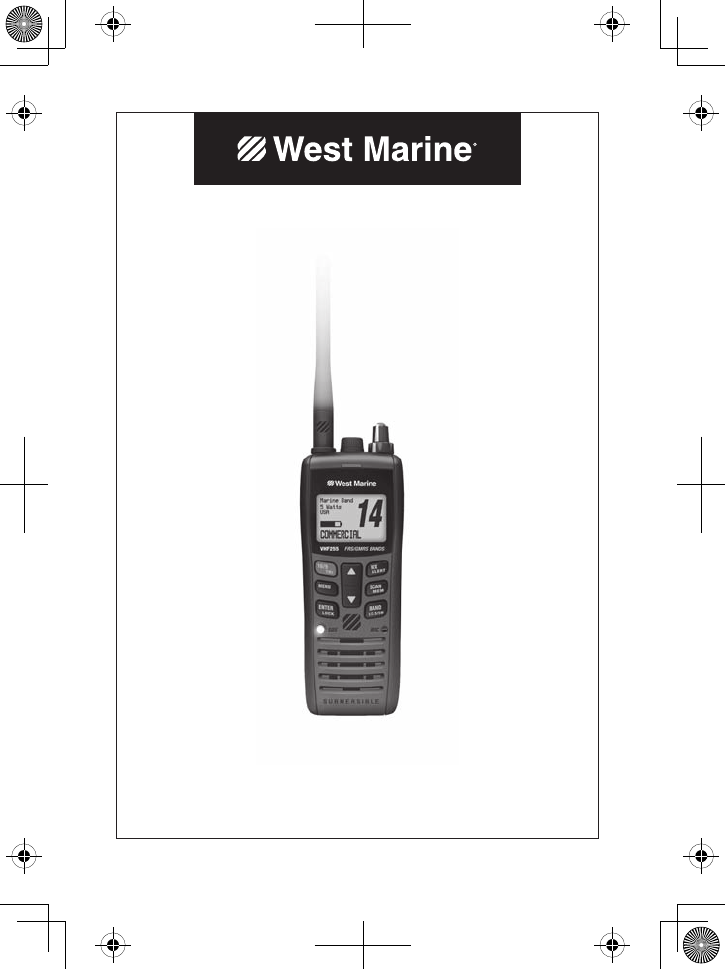
Owner’s Manual
Guide d’utilisation
Model / Modèle 12019113
VHF255
A
VHF255
Floating Dual Band
Two-Way Marine Radio
Radio maritime bidirectionnelle
à deux bandes

Making a Distress Call
Speak slowly - clearly - calmly.
For future reference, write your boat’s name & call sign here:
Make sure your radio is on.
On the radio, press the 16/9-Tri button to switch to Channel 16 (156.8
MHz). (If the corner of the display does not show 16, press the 16/9-
Tri button again until it does.)
Press the push to talk button on the microphone and say: “MAYDAY
-- MAYDAY -- MAYDAY.”
Say “THIS IS
{name of your boat (three times) and call sign/boat
registration number (once)}.
”
Say “MAYDAY
{name or call sign of your boat}.
”
Tell where you are: (what navigational aids or landmarks are near, or
read the latitude and longitude from your GPS).
State the nature of your distress, (e.g. are you sinking, medical
emergency, man overboard, on re, adrift, etc.)
State the type of assistance you need (medical, towing, pumps, etc.).
Give number of persons aboard and conditions of any injured
persons.
Estimate present seaworthiness of your ship (e.g. how immediate is
the danger due to ooding or re or proximity to shore).
Briey describe your ship, giving the ship name (e.g. “Blue Duck is a
32 foot cabin cruiser, white hull, blue deck house”).
Say: “I WILL BE LISTENING ON CHANNEL 16.”
End message by saying “THIS IS
{name or call sign of your boat}
,
OVER.”
Release the push to talk button and listen.
If you do not get an answer after 30 seconds, repeat your call,
beginning at step 3, above.
1.
2.
3.
4.
5.
6.
7.
8.
9.
10.
11.
12.
13.
14.
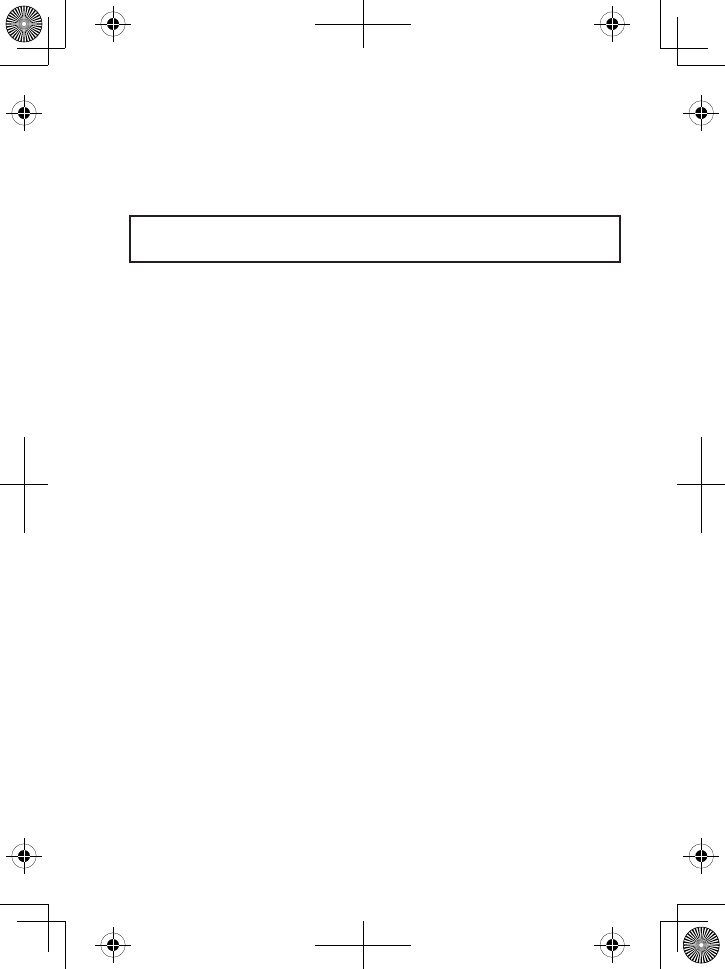
Faire un appel de détresse
Faire un appel de détresse vocal
Parlez lentement – clairement – calmement.
Pour toute référence ultérieure, transcrivez ci-dessous le nom et l’indicatif
d’appel de votre bateau :
Vériez si votre radio est en marche.
Appuyez sur la touche 16/9-Tri de la radio an de commuter au canal
16 (156,8 MHz). (Si le canal 16 n’apparaît pas à l’afchage, appuyez de
nouveau sur la touche 16/9-Tri jusqu’à ce qu’il soit afché.)
Appuyez sur le bouton de microphone push to talk et dites :“MAYDAY
- MAYDAY – MAYDAY”.
Donnez l’identité de votre navire en disant : “ICI {nom de votre bateau
(trois fois) ou indicatif d’appel et le numéro d’identication de votre
bateau (une fois)}”.
Dites “MAYDAY {nom ou indicatif d’appel de votre bateau} une fois”.
Donnez votre position : (quels sont les points de repère ou aides à la
navigation près de vous ou lisez les coordonnées de longitude et de
latitude apparaissant sur votre dispositif GPS).
Révélez la nature de votre détresse (par exemple, nous sommes en
train de couler, urgence médicale, un homme à la mer, un incendie,
nous sommes à la dérive, etc.
Révélez la nature de l’assistance désirée (médicale, remorquage,
essence, etc.)
Donnez le nombre de personnes à bord et les conditions des blessés, s’il y en a.
Donnez la condition de navigabilité actuelle de votre navire, tel que le
degré de l’urgence par rapport à l’inondation, à l’incendie ou à votre
proximité de la côte.
Donnez une brève description de votre navire en donnant le nom du
bateau (par exemple, “Blue Duck est un yacht de croisière de 32 pieds,
avec une coque blanche et un roufe bleu.”).
Dites : “JE VAIS ÉCOUTER SUR LE CANAL 16”.
Terminez le message en disant “ICI {nom ou indicatif d’appel de votre
bateau}, À VOUS”.
Relâchez le bouton push to talk du microphone et écoutez.
Si vous n’obtenez pas de réponse après 30 secondes, répétez l’appel
encommençant à l’étape 3 ci-dessus.
1.
2.
3.
4.
5.
6.
7.
8.
9.
10.
11.
12.
13.
14.

Table of Contents
Faire un appel de détresse vocal iii
Introduction ..............................E-1
Features ................................... E-1
Getting Started .........................E-3
What’s Included ........................ E-3
Parts of the VHF255 ................. E-4
Front view ..................................E-4
Back view ..................................E-4
Charger .....................................E-6
Using the Menus ....................... E-6
Using Your Radio (General
Operation) ............................ E-6
Changing the Volume ...............E-6
Setting the Squelch Level .........E-7
Changing the Channel ..............E-7
Contrast .....................................E-8
Lamp adjust ...............................E-8
Turning the Key Beep
On and Off ............................E-9
Using the external
speaker/mic jack ..................E-9
How It Works ..........................E-10
Normal mode operation ...........E-11
Normal mode with
Weather Alert Watch ...........E-12
Normal mode with Triple
Watch or Dual Watch ..........E-12
Normal mode with
Quad Watch ........................E-13
Scan mode operation ............. E-13
Using the radio in
scan mode .........................E-14
Scan mode with Weather
Alert Watch ..........................E-14
Scan mode with Triple
Watch or Dual Watch ..........E-15
Both Weather Alert and Triple/
Dual Watch in scan mode ...E-15
Weather mode ........................ E-15
Using the radio in
weather mode .....................E-16
Weather mode with
Weather Alert Watch ...........E-16
Weather mode with Triple
Watch or Dual Watch ..........E-16
Using the Marine VHF
Band .....................................E-17
Making a Transmission ........... E-19
Boosting the transmission
power ..................................E-19
Setting the UIC Channel
Mode .................................. E-20
Using the Strobe SOS Light ... E-20
Using the FRS/GMRS Band ..E-21
GMRS License ....................... E-21
FRS/GMRS Band Features ... E-21
Reading the FRS/GMRS
band screen ........................ E-22
FRS/GMRS band
menu options ......................E-22
Setting CTCSS/DCS
privacy codes ......................E-22
Setting Up the Hardware .......E-25
Installing the Battery ............... E-25
Making a Distress
Call ..............(inside front cover)

Using the Alkaline Battery
Case ................................... E-25
Mounting the Charger ............. E-27
Charging the Battery ............... E-27
Important notes on
charging the battery ............ E-28
Attaching the Belt Clip ............ E-28
Maintenance and
Troubleshooting ..................E-30
Common Questions ................ E-30
Specications ........................E-32
Regulations and Safety
Warnings..............................E-43
Three Year Limited
Warranty Statement ............E-46


E-1
West Marine VHF255 Radio Owner’s Manual
Introduction
Features
Your radio provides the following key features:
Submersible design
Complies with oating JIS8/IPX8 water-resistant
standards, which means the radio can be submerged in
1.5 meters of water for 30 minutes without damage.
The radio will only meet this rating if fully assembled
and all rubber seals and sealing plugs are well
maintained and correctly tted. This means that the
speaker microphone is attached or the sealing plug is
tted, and the battery pack (or case) and antenna are
attached and securely fastened.
After your radio is submerged in water, you might
notice that the sound is distorted. This is because
there is still water remaining in and around the speaker
and microphone. Just shake the radio to clear excess
water, and the sound will return to normal.
If your radio is exposed to salt water, clean it
thoroughly with fresh water.
The charging equipment is not waterproof.
Memory scan mode
Lets you save channels to memory and monitor them in
quick succession.

E-2 West Marine VHF255 Radio Owner’s Manual
Transmitter power level select
Lets you boost the transmitter power from 1 Watt to 2.5 or
5 Watts for added transmission distance.
Battery level icons and low battery alert
Dual, Triple and Quad Watch operation
These different watch modes let you monitor up to two
Coast Guard Distress/Hailing channels and one weather
channel along with one regular marine channel.
All marine VHF channels for the U.S., Canada, and
international waters
FRS/GMRS radio modes
Lets you use your radio to keep in touch with other
members of your party on shore or on another craft close
by.
National Oceanic and Atmospheric Administration (NOAA)
Weather Channel watch
Sounds a warning tone when a hazard alert is issued.
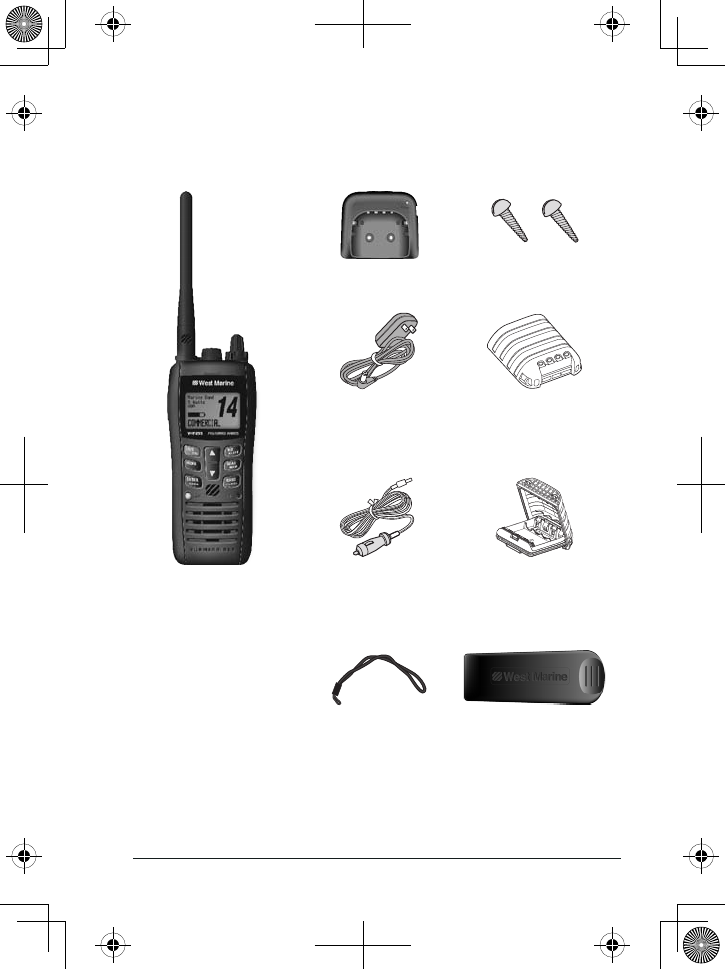
E-3
West Marine VHF255 Radio Owner’s Manual
Getting Started
What’s Included
Charging Cradle
12012589
Screws for
Charging Cradle
AC-DC Charging
Adapter
12012571
Lithium Ion Battery
12012555
VHF255 Radio
with Antenna
DC Charging
Adapter
12012563
Alkaline Battery Tray
(batteries not included)
12303038
Wrist Strap
12012548
Belt Clip
7830458
If any pieces are missing or damaged, contact West
Marine (see back cover for contact information).
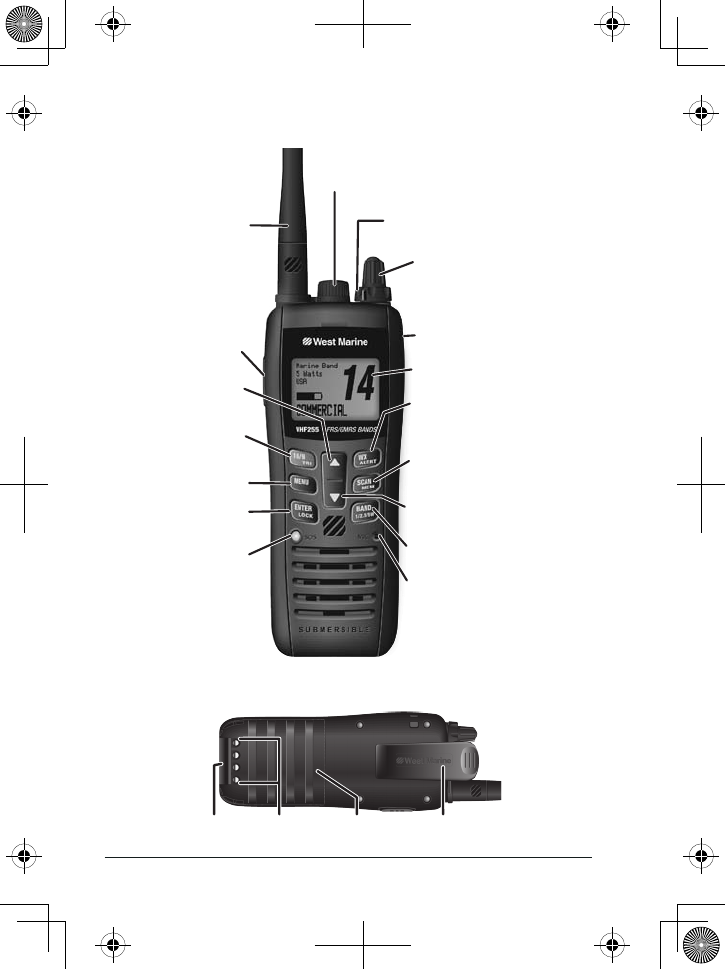
E-4 West Marine VHF255 Radio Owner’s Manual
Parts of the VHF255
Front view
Back view
Volume-power knob
(Turn clockwise to
increase volume.)
16/9 - TRI
(16/9-triple
watch button )
WX - ALERT
(weather alert)
button
SCAN - MEM
(scan-memory)
button
BAND - 1/2.5/5W
button
Full dot matrix display
MENU
button
ENTER-LOCK
button
Microphone
Strobe
SOS light
Squelch knob
(Turn clockwise to
decrease channel noise.)
Channel up
button
Channel down
button
Push to talk
button
Wrist strap
anchor
Speaker Microphone
port and sealing cap
Antenna
Volume-power knob
(Turn clockwise to
increase volume.)
16/9 - TRI
(16/9-triple
watch button )
WX - ALERT
(weather alert)
button
SCAN - MEM
(scan-memory)
button
BAND - 1/2.5/5W
button
Full dot matrix display
MENU
button
ENTER-LOCK
button
Microphone
Strobe
SOS light
Squelch knob
(Turn clockwise to
decrease channel noise.)
Channel up
button
Channel down
button
Push to talk
button
Wrist strap
anchor
Speaker Microphone
port and sealing cap
Antenna
Belt clip
Battery
Battery charging
contacts
Battery
latch Belt clip
Battery
Battery charging
contacts
Battery
latch
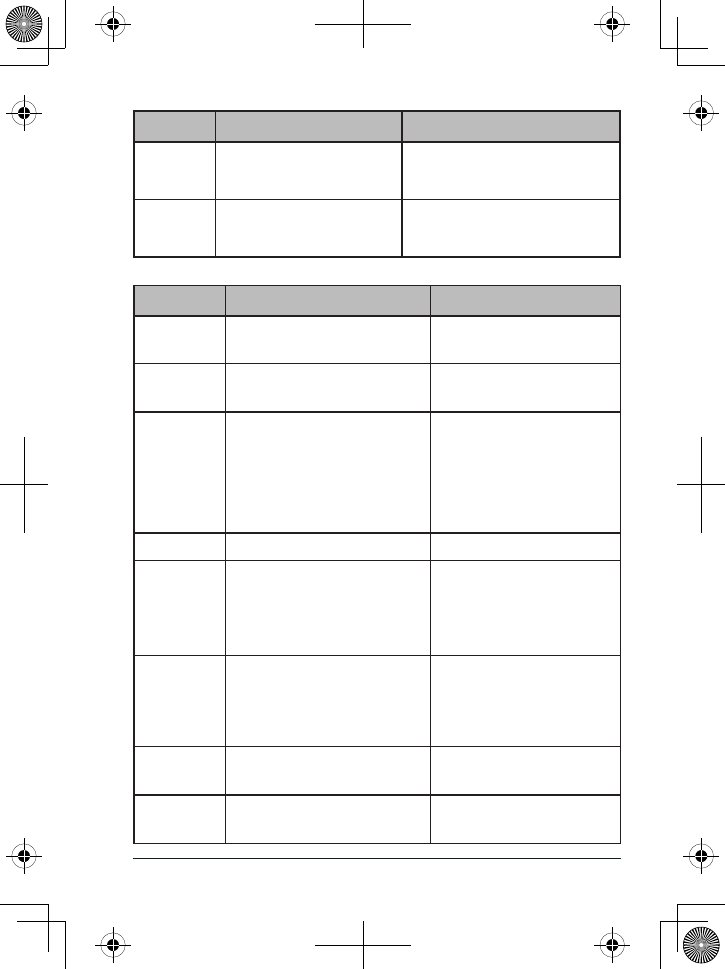
E-5
West Marine VHF255 Radio Owner’s Manual
Knob Turn clockwise to... Turn counter-clockwise to...
Squelch Raise the squelch level
to reduce channel noise. Lower the squelch level to
hear weaker signals.
Volume-
Power Turn on the radio or
increase the volume.
Decrease the volume or turn
off the radio.
Button Press to... Press and hold to...
Push to
talk NA Transmit on a channel
Channel
up Move up one channel at
a time. Move quickly up the
channels.
16/9 - TRI
(Red)
1st press: Go to channel
16.
2nd press: Go to channel 9.
3rd press: Go back to the
starting channel.
Turn Triple Watch on
and off.
MENU Access the radio menus. NA
ENTER -
LOCK
Select menu items.
Return to normal marine
VHF screen while marine
channel list is displayed.
–
–Lock the keys; press and
hold again to unlock.
WX -
ALERT
Listen to the weather
channels or return to the
last channel of the previous
radio band.
Turn Weather Alert Watch
on and off.
SCAN -
MEM Enter or exit SCAN mode. Store the current working
channel into memory.
BAND -
1/2.5/5W Switch the band between
VHF and FRS/GMRS. Change the transmit
power (see page E-11).
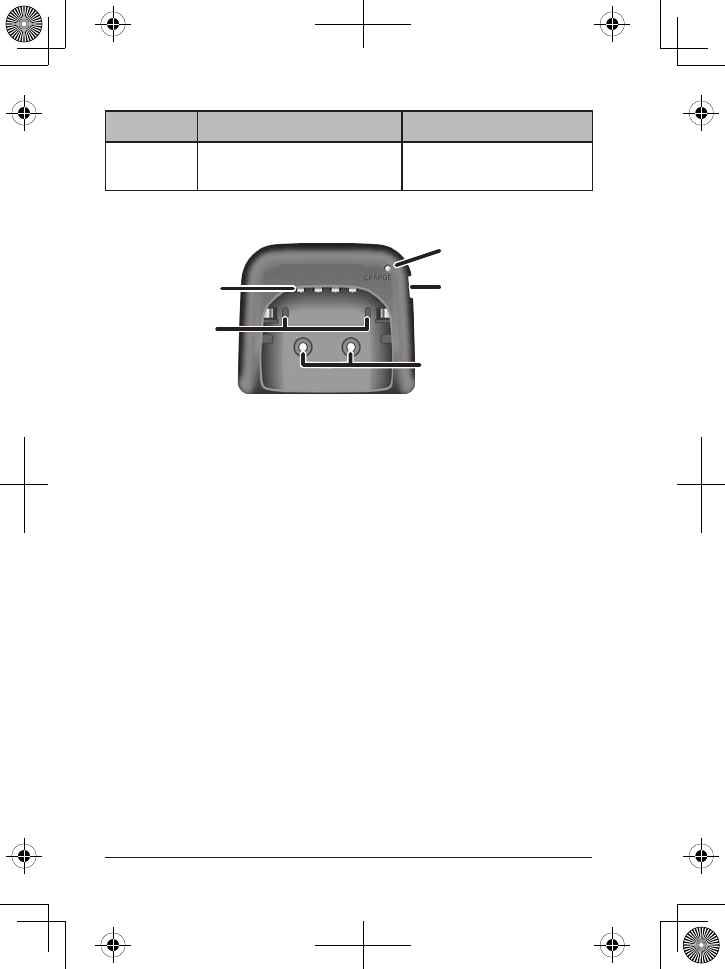
E-6 West Marine VHF255 Radio Owner’s Manual
Button Press to... Press and hold to...
Channel
down Move down one channel at
a time. Move quickly down the
channels.
Charger
Using the Menus
Here are some general hints on operating the VHF255
menu screens.
The current item is highlighted in reversed out text.
Use Channel up to move up a line in the menu.
Use Channel down to move down a line in the menu.
Press ENTER - LOCK to choose the selected item.
Select
Exit
to close the menu
Using Your Radio (General Operation)
Changing the Volume
To increase the speaker volume, turn the Volume-Power
knob clockwise; turn it counter-clockwise to decrease the
volume.
Charging
contacts
CHARGE LED
Screw holes
for mounting
Power jack
Charging
latches
Charging
contacts
CHARGE LED
Screw holes
for mounting
Power jack
Charging
latches
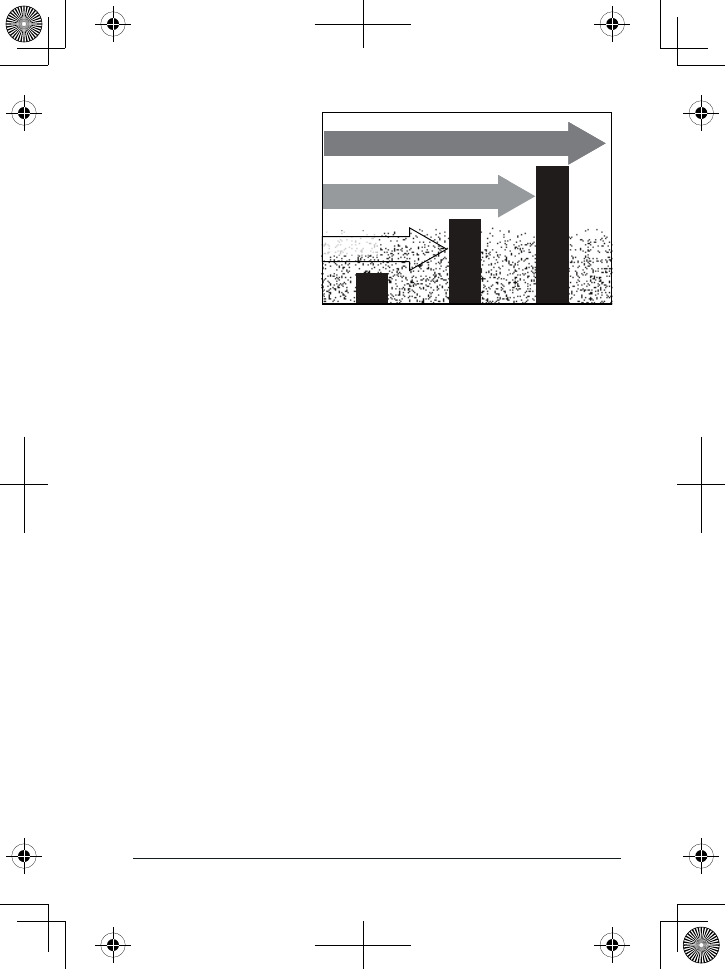
E-7
West Marine VHF255 Radio Owner’s Manual
Setting the
Squelch Level
The squelch feature
reduces static on
the speaker by
ltering out any
background
channel noise. At
the lowest squelch
level, the speaker
plays all signals,
including any channel noise. Setting the squelch level
higher lters out noise and lets only actual radio
transmissions through.
While listening to a channel, adjust the SQUELCH knob
until the noise is ltered and you can hear only the
transmission. If you switch to a channel with a lot of noise
or a weak trans-mission, you may need to readjust the
squelch level again.
Setting the squelch level too high may prevent you from
hearing weaker transmissions. If you are having difculty
hearing a transmission, try setting the squelch level lower.
Changing the Channel
Press Channel up and Channel down briey to scroll through
the channels one channel at a time. Press and hold
Channel up or Channel down to quickly scroll through the
channels.
Weak signals
No
Squelch
Medium
Squelch High
Squelch
Strong signals
Noise
Weak signals
No
Squelch
Medium
Squelch High
Squelch
Strong signals
Noise

E-8 West Marine VHF255 Radio Owner’s Manual
Contrast
The display has 10 levels of contrast for each LCD
display format: light letters on a dark background or dark
letters on a light background. Scrolling from 1 to zero
switches the contrast. To adjust the contrast:
Press the MENU button and select Contrast/RVS.
Use Channel up and Channel down to change the contrast
to your desired level.
Press ENTER to set the new contrast level and exit the
menu.
Lamp adjust
The LCD and keypad light up whenever you press a key
on the radio; the backlight stays on for 5 seconds and
then turns off automatically. You can change the amount
of time the LCD and keypad backlight stays on.
Press the MENU button and choose Lamp Adjust.
Choose how you want the backlight to operate:
Always On makes the backlight stay on.
Always Off makes the backlight never come on
Timer makes the backlight stay on for a set amount
of time after you press a key.
Color
lets you select green or orange background.
If you select Timer, the radio prompts you to choose
the amount of time you want the backlight to stay
on. Choose from
5 seconds
,
10 seconds
(default),
30
Seconds
,
1 Minute
, or
5 Minutes
.
Press ENTER to save the new setting.
1)
2)
3)
1)
2)
3)
4)

E-9
West Marine VHF255 Radio Owner’s Manual
Turning the Key Beep On and Off
Key beep is the tone that sounds when you press a key
or a button. You can turn this tone on and off by using the
Key Beep
menu.
From the
Main
menu, select
Key Beep
; press ENTER -
LOCK to display the
Key Beep
screen.
Select
ON
or
OFF
and press ENTER - LOCK. The radio
returns to the
Marine Main
menu.
Press MENU to return to the main screen.
Using the external speaker/mic jack
You can connect an optional external speaker-mic (SM81
- part number 12012597) to this watertight jack. Unscrew
the cap, which is held by the rubber cap-keeper to
prevent loss. Insert the special gasketed plug and screw
down the shell, which prevents water from entering the
jack.
For details, consult your West Marine dealer or contact West
Marin directly (see back cover for contact information).
1.
2.
3.
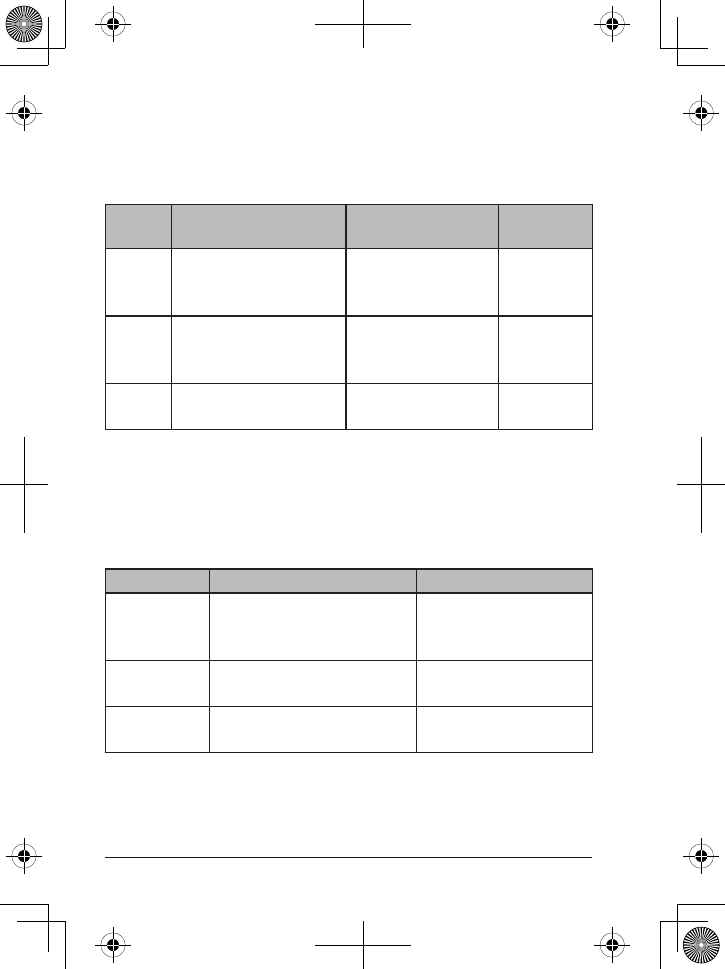
E-10 West Marine VHF255 Radio Owner’s Manual
How It Works
Your radio has three main operation modes: normal,
scan, and weather.
Mode What it does Use it when you
want to... To turn it
on/off
Normal Monitors a single marine
channel and lets you
talk on that channel.
Monitor a channel or
talk to another radio. (default
mode)
Scan Monitors all the
channels you save into
memory.
Check a small group
of regularly-used
channels for trafc.
Press SCAN
- MEM.
Weather Monitors the selected
NOAA weather channel. Hear the current or
forecasted weather. Press WX-
ALERT.
In addition to the three operation modes, your radio
provides four different watch modes which you can
activate during any operation mode. In the watch modes,
the radio briey checks for activity on a specic channel,
then returns to its previous operation.
Watch mode What it does To turn it on/off
Weather Alert
Watch
Checks the last-used weather
channel for hazard alerts
every 7 seconds.
Press and hold WX-
ALERT for 2 seconds.
Dual Watch Checks channel 16 for
activity every 2 seconds. Press and hold SCAN -
MEM for 2 seconds.
Triple Watch Checks channels 16 and 9
for activity every 2 seconds. Press and hold BAND -
16/9-TRI for 2 seconds.
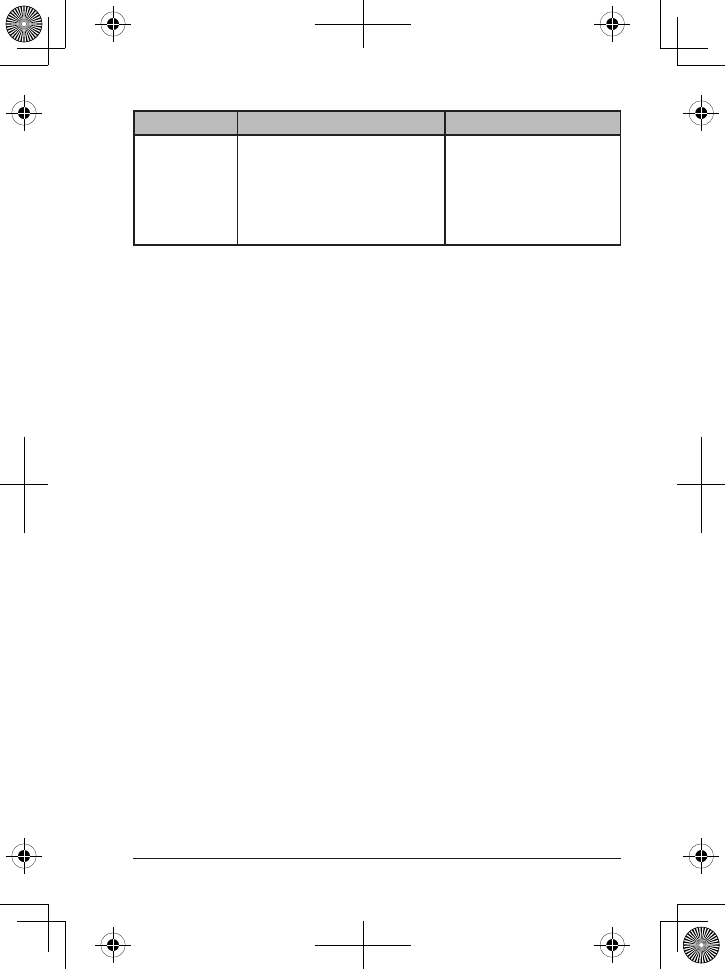
E-11
West Marine VHF255 Radio Owner’s Manual
Watch mode What it does To turn it on/off
Quad Watch
Checks channels 16 and 9
for activity every 2 seconds,
and checks the last-used
weather channel every 7
seconds.
Turn on Triple Watch,
then turn on Weather
Alert Watch.
Private boats must monitor channel 16 whenever they are
underway. Water-going vessels should have either Triple
Watch or Dual Watch on at all times.
Normal mode operation
To transmit, remove the radio from the charger, then
press and hold Push to talk. Release the button when
you are nished talking.
For the best sound quality, hold the microphone about
two inches from your mouth while you’re talking.
Press Channel up to move up one channel at a time.
Press and hold the button to scroll quickly up the
channels.
Press Channel down to move down one channel at a
time. Press and hold the button to scroll quickly down
the channels.
To change the transmit power, press BAND - 1/2.5/5W.
The transmit power switches to the next transmit power
each time you press this button.
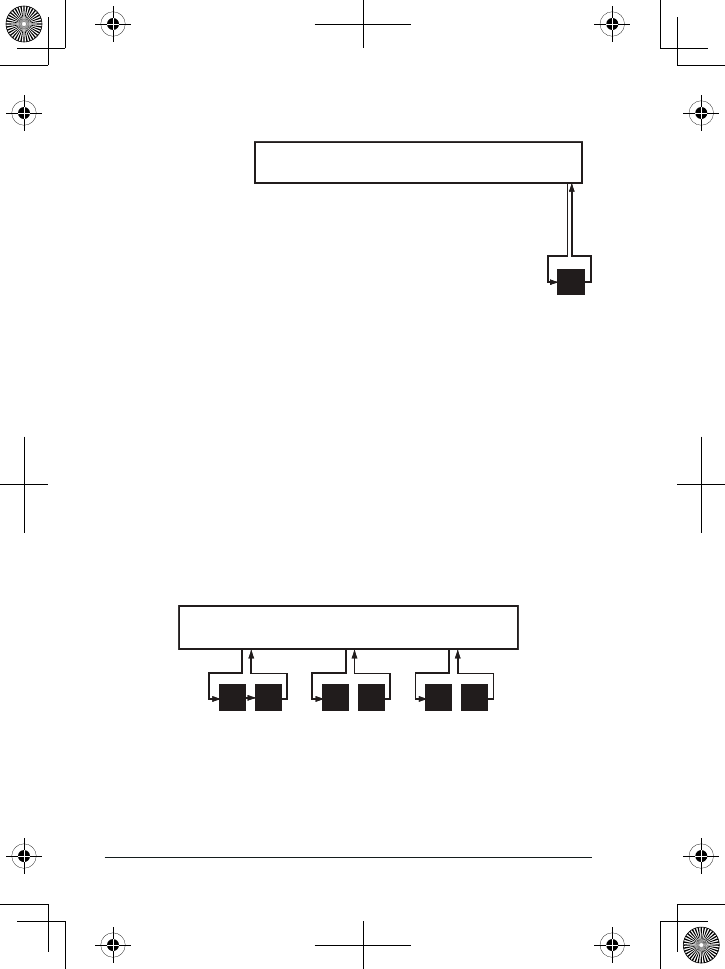
E-12 West Marine VHF255 Radio Owner’s Manual
Normal mode with Weather Alert Watch
If you activate
Weather Alert
Watch while
operating in
normal mode, the radio checks the
most recently used weather channel
every seven seconds. If it detects a
weather or other hazard alert, it will
switch to that weather channel. (If
you are actively transmitting, the
radio waits until you nish your
transmission before checking the weather channel.)
Normal mode with Triple Watch or Dual Watch
If you activate Triple Watch while operating in normal
mode, the radio checks channels 16 and 9 every two
seconds; with Dual Watch turned on, the radio only
checks channel 16. The radio will not check channels 16
or 9 while you are actively transmitting; it waits until your
transmission is nished and then checks the channels.
wx
Every 7 seconds,
the radio checks
the last-used
weather channel.
WX Alert
Watch on
Monitoring Channel 25
wx
Every 7 seconds,
the radio checks
the last-used
weather channel.
WX Alert
Watch on
Monitoring Channel 25
09 16 09 16 09 16
Every 2 seconds, the radio
checks channels 9 & 16.
Triple Watch on
Monitoring Channel 25
09 16 09 16 09 16
Every 2 seconds, the radio
checks channels 9 & 16.
Triple Watch on
Monitoring Channel 25
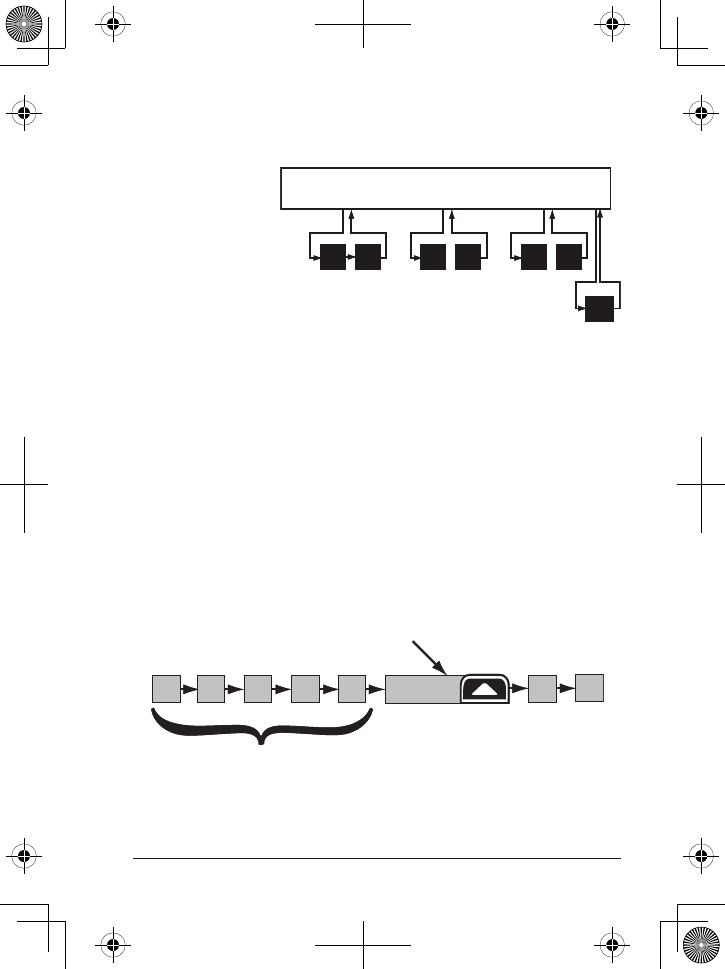
E-13
West Marine VHF255 Radio Owner’s Manual
Normal mode with Quad Watch
You can activate Weather Alert Watch and Triple Watch at
the same time
to monitor four
channels at
once (Quad
Watch). The
radio performs
the Triple Watch
and Weather
Alert Watch
checks at their
scheduled time.
Scan mode operation
You can save channels into memory and then use scan
mode to monitor those channels from lowest to highest. If
the radio detects a signal on a channel, it stays on that
channel as long as the signal is received; when the signal
stops, the radio continues scanning.
wx
Every 7 seconds,
the radio checks
the last-used
weather channel.
WX Alert
Watch on
09 16 09 16 09 16
Every 2 seconds, the radio
checks channels 9 & 16.
Triple Watch on
Monitoring Channel 25
wx
Every 7 seconds,
the radio checks
the last-used
weather channel.
WX Alert
Watch on
09 16 09 16 09 16
Every 2 seconds, the radio
checks channels 9 & 16.
Triple Watch on
Monitoring Channel 25
11
1008 1312 14 17
15
The radio scans about
5 channels in 0.5 seconds.
When it detects a signal, the radio stays
on the channel until you press the
Channel up button or the signal stops. Resume
scan
11
1008 1312 14 17
15
The radio scans about
5 channels in 0.5 seconds.
When it detects a signal, the radio stays
on the channel until you press the
Channel up button or the signal stops. Resume
scan
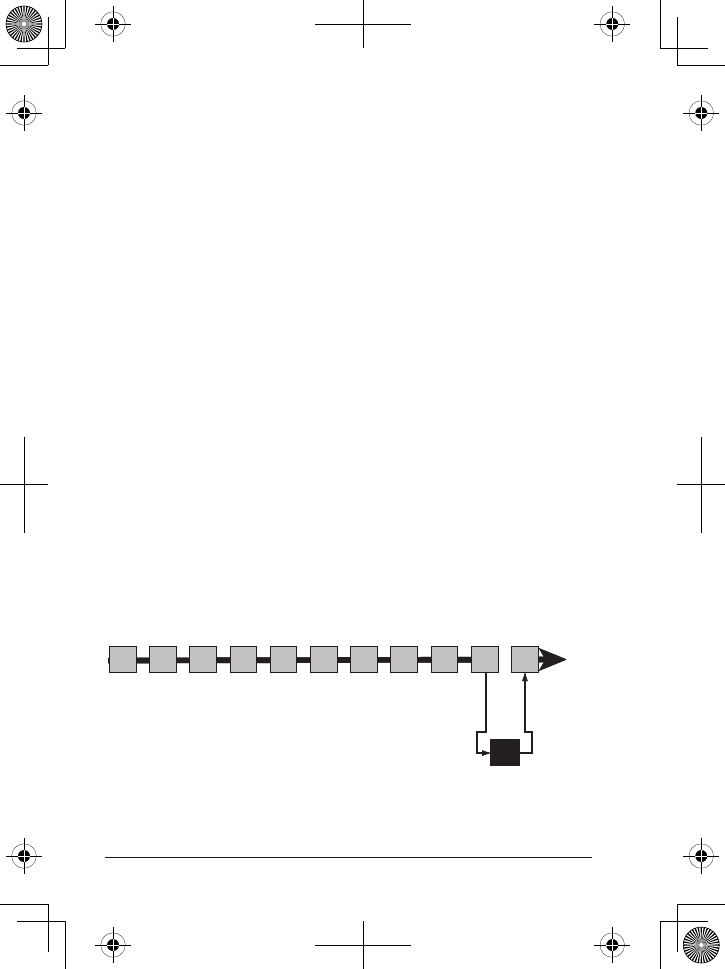
E-14 West Marine VHF255 Radio Owner’s Manual
Using the radio in scan mode
To activate scan mode, press SCAN - MEM.
You must have at least two channels in memory to start
a scan.
You cannot transmit while in scan mode.
To save a channel into memory, select the channel,
then press and hold SCAN-MEM.
MEMORY
displays
whenever you tune to that channel.
To remove a channel from memory, set the radio to
that channel, then press and hold SCAN-MEM again.
MEMORY
no longer displays.
When the radio stays on a channel, press SCAN - MEM
to leave that channel and resume scanning.
To stop scanning, press the SCAN - MEM button again;
the radio remains on the last scanned channel.
Scan mode with Weather Alert Watch
If you activate Weather Alert Watch while in scan mode,
the radio checks the most recently-used weather channel
every seven seconds, then continues scanning the next
channel in memory:
Every 7 seconds, the radio
checks the last-used
weather channel, then
scans the next channel. wx
WX Alert
Watch on
Memory Channel Scan
08 252417151413121110 20
Every 7 seconds, the radio
checks the last-used
weather channel, then
scans the next channel. wx
WX Alert
Watch on
Memory Channel Scan
08 252417151413121110 20
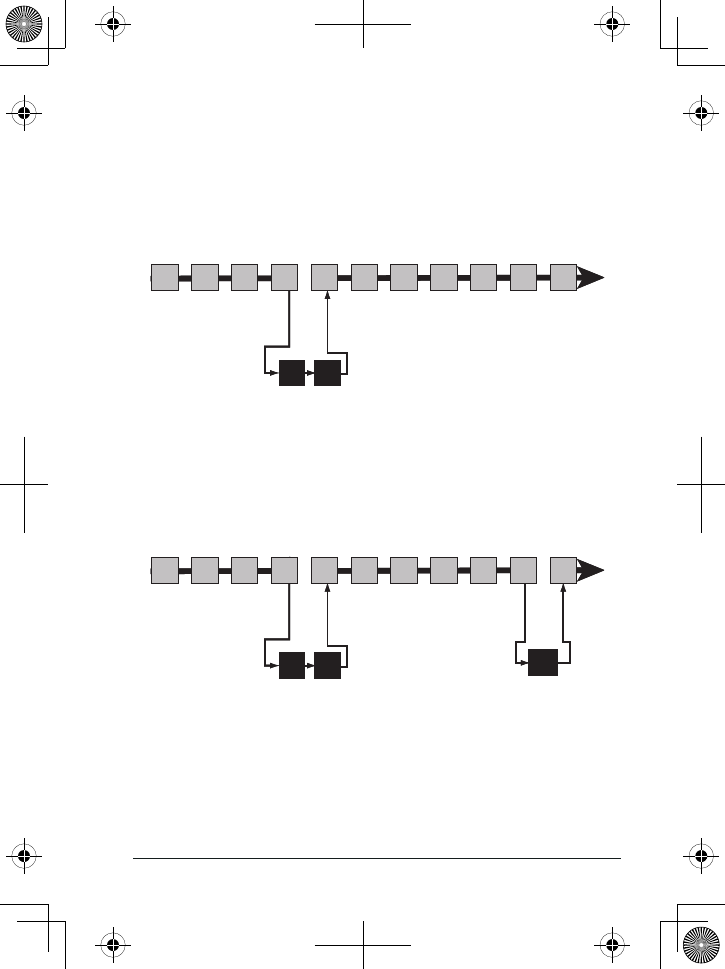
E-15
West Marine VHF255 Radio Owner’s Manual
Scan mode with Triple Watch or Dual Watch
If you activate Triple Watch while operating in scan mode,
the radio checks channels 16 and 9 every two seconds,
then goes on to scan the next channel; with Dual Watch
turned on, the radio only checks channel 16:
Both Weather Alert and Triple/Dual Watch in scan mode
You can activate Weather Alert Watch and Triple/Dual
Watch at the same time. The radio performs both checks
at their scheduled time:
Weather mode
The NOAA weather channels now cooperate with the
FCC to alert you of other hazards besides weather (child
abduction alerts, nuclear, biological, etc.). In weather
09 16
Every 2 seconds, the
radio checks channels
9 & 16, then scans
the next channel.
Triple
Watch on
Memory Channel Scan
08 252417151413121110 20
09 16
Every 2 seconds, the
radio checks channels
9 & 16, then scans
the next channel.
Triple
Watch on
Memory Channel Scan
08 252417151413121110 20
09 16
Every 2 seconds, the
radio checks channels
9 & 16, then scans
the next channel.
Triple
Watch on
Every 7 seconds, the radio
checks the last-used
weather channel, then
scans the next channel. wx
WX Alert
Watch on
Memory Channel Scan
08 252417151413121110 20
09 16
Every 2 seconds, the
radio checks channels
9 & 16, then scans
the next channel.
Triple
Watch on
Every 7 seconds, the radio
checks the last-used
weather channel, then
scans the next channel. wx
WX Alert
Watch on
Memory Channel Scan
08 252417151413121110 20
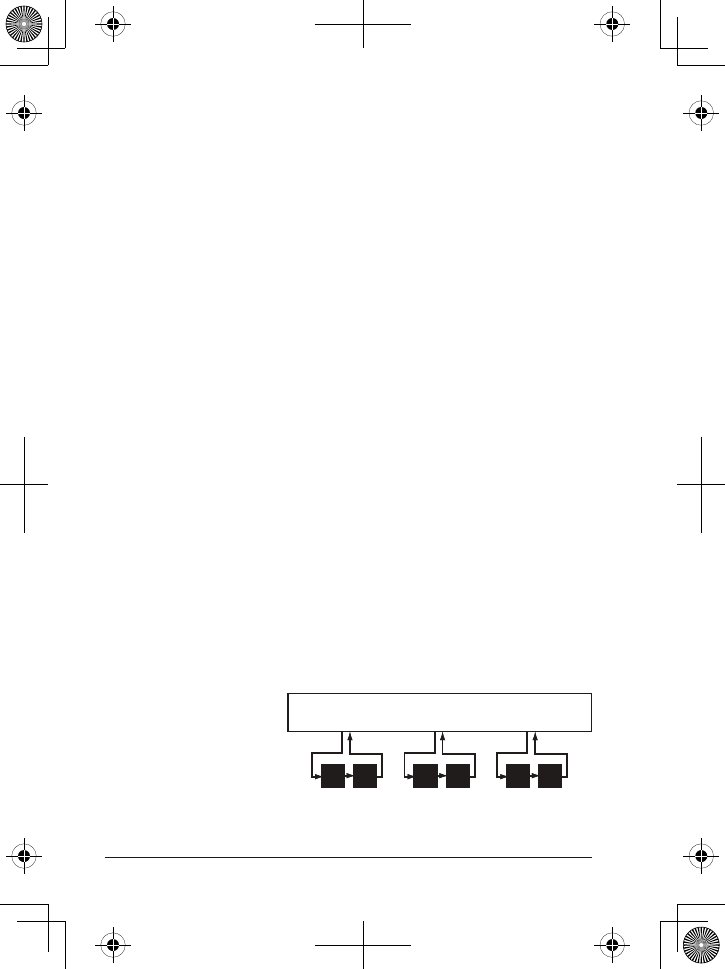
E-16 West Marine VHF255 Radio Owner’s Manual
mode, the radio monitors one of the ten NOAA weather
channels. If any type of alert is received, the radio sounds
an alert tone and the display blinks.
Using the radio in weather mode
You cannot transmit while in weather mode.
To enter weather mode, press the WX - ALERT button.
To turn off the radio’s alert tone, press any button.
To cancel weather mode and return to the previous
marine channel, press the WX - ALERT button again.
Weather mode with Weather Alert Watch
Because weather mode already monitors the weather
channels, you don’t need Weather Alert Watch to check
the weather channel every seven seconds. If you activate
Weather Alert Watch while operating in weather mode,
it operates as a type of “sleep mode:” the radio stays on
the weather channel and mutes the speaker. If an alert
is detected, the radio sounds an alert tone and turns the
speaker back on. This mode is very useful when you
are anchoring for the night but want to keep informed of
hazards.
Weather mode with Triple Watch or Dual Watch
If you activate Triple Watch while operating in weather
mode, the radio
checks channels 16
and 9 every two
seconds; with Dual
Watch turned on,
the radio only
checks channel 16.
09 16 09 16 09 16
Every 2 seconds, the radio checks
channel 9, then channel 16
with Triple Watch on
Monitoring Weather Channel WX08
09 16 09 16 09 16
Every 2 seconds, the radio checks
channel 9, then channel 16
with Triple Watch on
Monitoring Weather Channel WX08
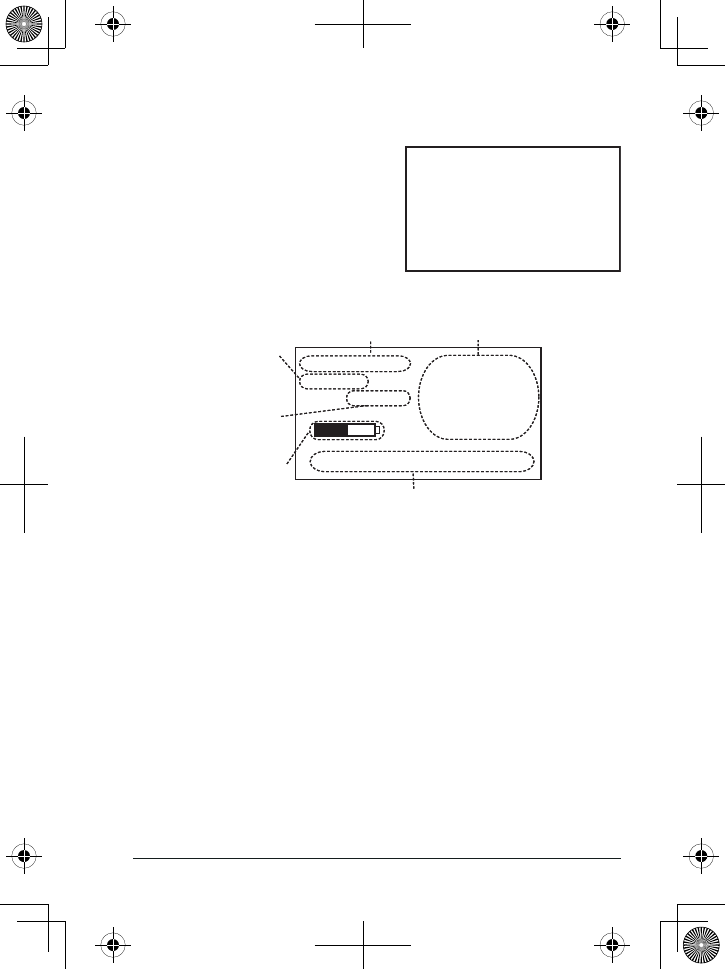
E-17
West Marine VHF255 Radio Owner’s Manual
Using the Marine VHF Band
The following features and
options are available only when
the radio is in the marine VHF
band. Press BAND - 1/2.5/5W until
the display shows VHF.
Reading the marine band
screen
Marine band menu options
Follow the steps below to open the marine band menu:
If the top of the display does not show Marine Band,
press the BAND-1/2.5/5W button until VHF displays.
Wait for the display to show the marine band screen,
then press the MENU button.
Refer to the table below for the available options and
settings available in the marine band.
1)
2)
3)
VHFVHF
Marine Band
5 Watts
USA MEMORY
Marine Operator
88
Battery
level icon
Current channel
number
Status messages
Current band
Transmit
power
Channel
memory
Status
Marine Band
5 Watts
USA MEMORY
Marine Operator
88
Battery
level icon
Current channel
number
Status messages
Current band
Transmit
power
Channel
memory
Status
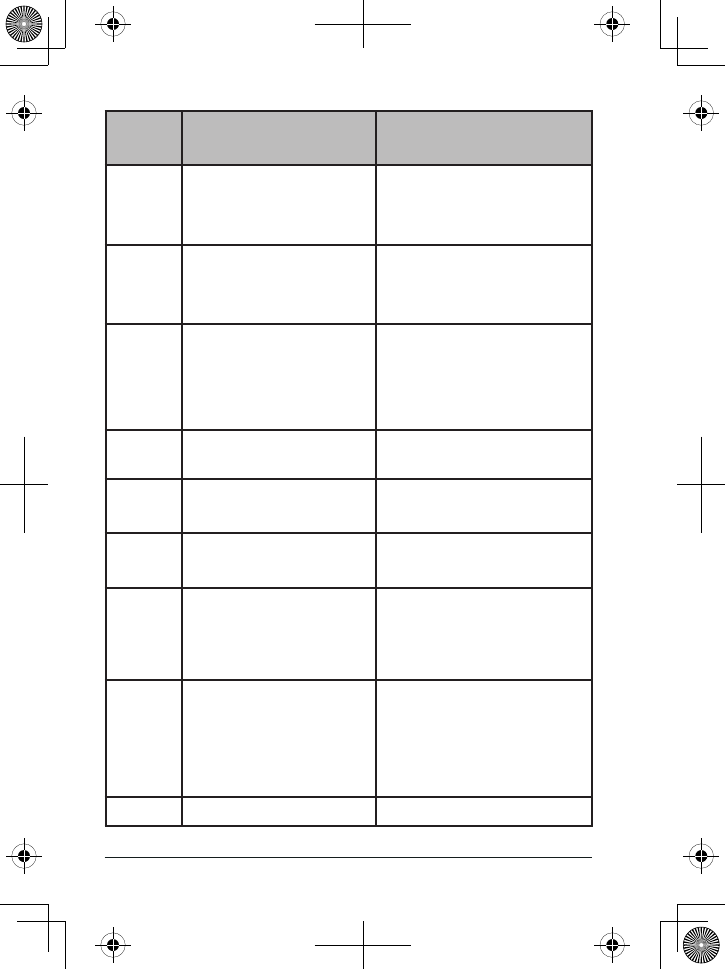
E-18 West Marine VHF255 Radio Owner’s Manual
Menu
Option Use It To... Available Settings
(default setting in italics)
USA/
CAN/
INT
Change the channel mode
from US to Canadian or
International channels
USA Mode
CANadian Mode
INTernational Mode
SOS
Light
Turn the strobe light on
or off.
Always on
Strobe SOS
Off
Lamp
Adjust
Change the operation
and color of the display
backlight
Always On
Timer
(see page 22 for details)
Always Off
Color
Contrast/
RVS.
Adjust the display contrast 10 contrast levels
(default = 7)
Dual/
TriWatch
Choose between triple
watch and dual watch
16/9 TriWatch
16 DualWatch
Key Beep
Turn the key touch tones
on or off
On
Off
FIPS
Codes
Enter or edit the six-digit
codes for the geographic
areas whose hazard alerts
you want to listen to.
No FIPS codes entered.
See page 28 for instructions
on entering FIPS codes.
Channel
Name
Change the name
displayed for a channel or
reset channel names back
to their default settings
See the tables starting on
page 42 for default channel
names.
See page 27 for instructions
on changing channel names.
Exit
Close the menu

E-19
West Marine VHF255 Radio Owner’s Manual
See the tables starting on page 42 for a list of receive-
only channels.
Making a Transmission
Select the channel you want to transmit on, then press
and hold Push to talk. Release Push to talk when you’re
nished talking to let the other party respond.
To prevent stuck microphone problems or situations
where Push to talk is pushed accidentally, the radio limits
your talk time to 5 minutes in a single transmission.
For the best sound quality, hold the microphone about
two inches away from your mouth.
See the channel lists starting on page E-34 for a list of
receive-only channels.
Boosting the transmission power
In most situations, the 1 Watt transmission power is all
you need. If you nd yourself far away from other stations
and have trouble getting a response, you may need to
boost the transmission power from 1 Watt to 2.5 Watts or
5 Watts:
Select the channel you want to transmit on.
Press and hold BAND - 1/2.5/5W to switch to the next
transmission power level (for example, from 5 Watt
to 2.5 Watts; from 2.5 Watts to 1 Watt, or from 1 Watt
back around to 5 Watts).
The display shows the new transmission power in the
lower left hand corner. The transmit power remains at
the new setting until you change it again.
Don’t forget to change the transmission setting back to 1
Watt when you move close to other stations.
1)
2)
3)

E-20 West Marine VHF255 Radio Owner’s Manual
Some channels (for example, channels 13 and 67) limit
the transmission power to 1 Watt. When you tune to a
limited-power channel, the radio automatically switches to
1 Watt. See the channel lists starting on page E-34 for a
list of power-restricted channels.
Setting the UIC Channel Mode
The radio is preset to US-assigned channels. Follow
these steps to change the channel mode to Canadian or
international channel assignments,
Open the menu and select
USA/CAN/INT
; press
ENTER - LOCK.
Scroll up or down to select the UIC channel mode
desired; press ENTER - LOCK.
The radio beeps twice and returns to the
Marine Menu
screen. Press MENU to return to the
Main
screen.
Using the Strobe SOS Light
You can use this radio in an emergency. If you turn on the
strobe SOS high-intensity LED light on your radio, your
radio will blink “S O S” in international Morse Code. This
will make it easier for rescuers to nd you faster. You can
also select a continuous light instead of the SOS pattern.
Your radio operates normally when the SOS LED strobe is
activated.
From the radio’s Main menu, select SOS Light and
press ENTER - LOCK.
Scroll up or down to select
Always On
,
Strobe
, or
Off
.
Press ENTER - LOCK. The
Marine Main
menu displays.
Press MENU to return to the main screen.
1.
2.
3.
1.
2.
3.
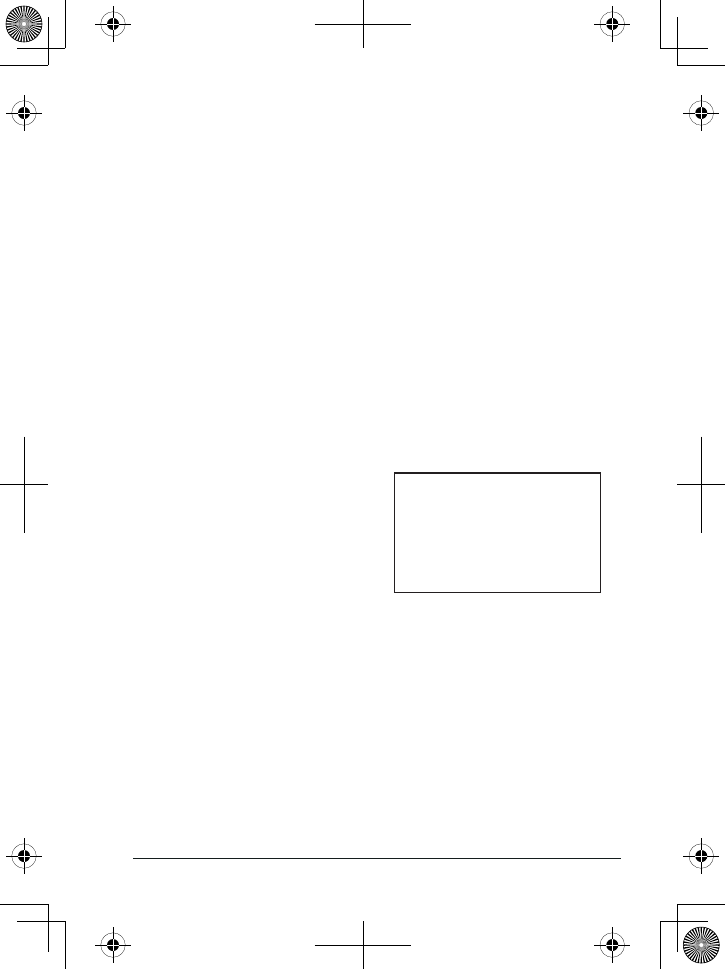
E-21
West Marine VHF255 Radio Owner’s Manual
Using the FRS/GMRS Band
GMRS License
The VHF255 can operate on the General Mobile
Radio Service (GMRS) frequencies. You must have a
GMRS license issued by the Federal Communications
Commission to legally use GMRS channels. For licensing
information and application forms, visit the FCC online
at: www.fcc.gov/wtb/uls or call the FCC Hotline at 1-800-
418-3676. If you have any questions, you can contact the
FCC directly at 1-888-255-5322. No license is required
for operation on non-GMRS channels or operation on any
channel in Canada.
FRS/GMRS Band Features
The following features and
options are avilable only when
the radio is in the FRS/GMRS
band. To activate this band,
press the BAND-1/2.5/5W button;
the display shows FRS/
GMRS.
FRS/GMRSFRS/GMRS
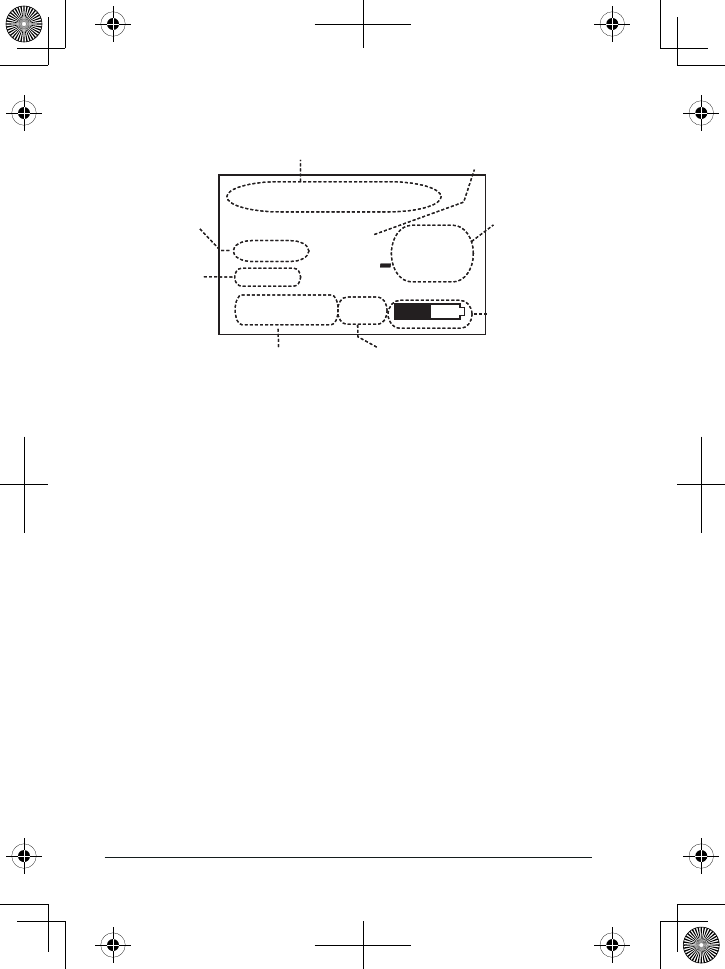
E-22 West Marine VHF255 Radio Owner’s Manual
Reading the FRS/GMRS band screen
FRS/GMRS band menu options
There are two differences between the Marine VHF band
and FRS/GMRS band menus:
USA/CAN/INT
,
FIPS Codes
, and
Channel Name
menus
appear on the Marine VHF band menu but not the
FRS/GMRS menu.
CTCSS
appears on the FRS/GMRS band menu but not
the Marine VHF band menu.
The other menu options are identical.
Setting CTCSS/DCS privacy codes
Normally, any FRS/GMRS radio that is within range
and using the same channel can hear FRS/GMRS
conversations. To prevent other radios from hearing
you or to reduce interference with other radios, you can
enable one of the 142 privacy codes for any channel.
Only radios that have the matching privacy code will be
able to decipher your transmission.
FRS/GMRS 2-Way Radio
Locked
Memory
Dual Watch Scan
14 CTCSS
027
Current
channel is
stored in
memory
Keypad
locked
Current channel
number
Status messages
Current band
Battery
level
icon
Channel
scanning on
Current
CTCSS/DCS
privacy
code
(001-142 or
OFF)
FRS/GMRS 2-Way Radio
Locked
Memory
Dual Watch Scan
14 CTCSS
027
Current
channel is
stored in
memory
Keypad
locked
Current channel
number
Status messages
Current band
Battery
level
icon
Channel
scanning on
Current
CTCSS/DCS
privacy
code
(001-142 or
OFF)
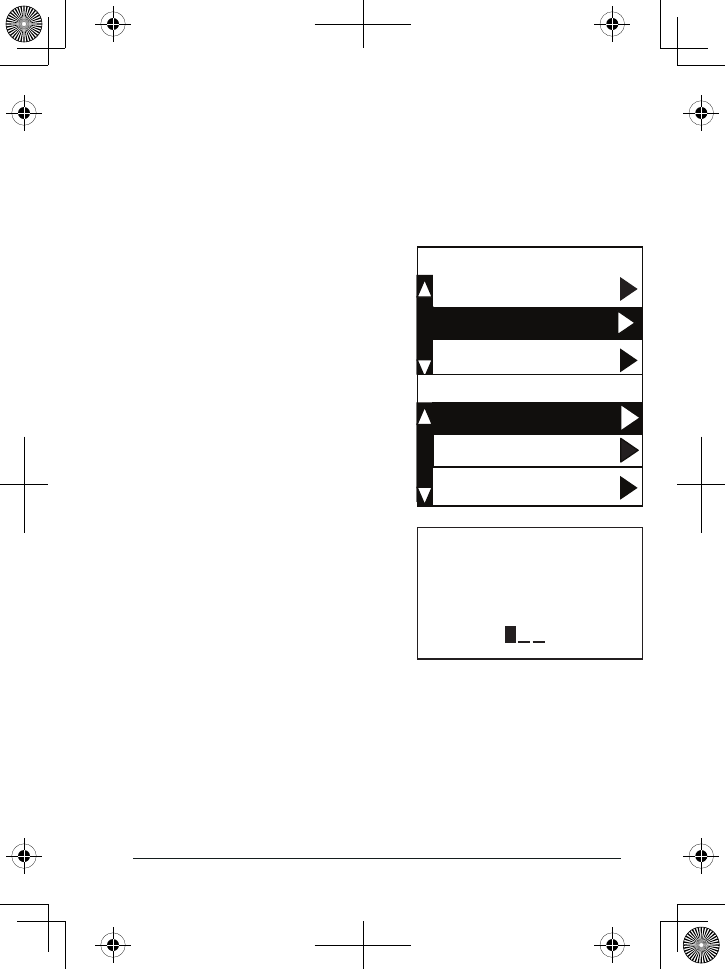
E-23
West Marine VHF255 Radio Owner’s Manual
Privacy codes are specic to each channel. Make sure the
person you want to communicate with has the same code set
on the same channel you do.
Open the
FRS/GMRS
menu. Select
CODE
and press ENTER-
LOCK.
The current FRS/GMRS
channel is highlighted. Use
the Channel up or Channel down
button to select a different
channel. Any channel that has
a privacy code enabled has
an asterisk in the display.
Choose On to enable a
privacy code on this channel
or choose Off to disable a
previously-set code.
Enter a code number between
001 and 142. Use the Channel
up and Channel down buttons to
change the rst digit; the
Channel up button increases
the number; the Channel down
button decreases the number.
1)
2)
3)
4)
Channel 11 *
Channel 09
CTCSS/DCS
Channel 10
Channel 11 *
Channel 09
CTCSS/DCS
Channel 10
Exit
On
CHANNEL 10-OFF
Off
Exit
On
CHANNEL 10-OFF
Off
press the enter key
the character then
arrow keys to select
Press the UP or DOWN
0
press the enter key
the character then
arrow keys to select
Press the UP or DOWN
0
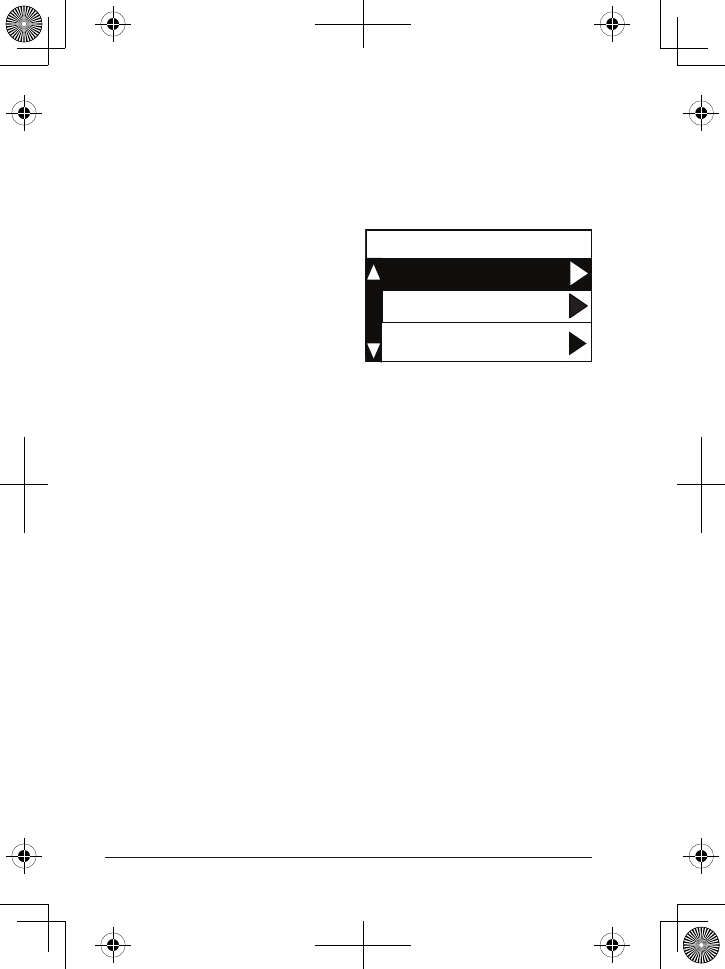
E-24 West Marine VHF255 Radio Owner’s Manual
When the rst digit is correct, press the ENTER-LOCK
button to move to the next digit. Enter the remaining
two digits of the code in the same way.
Note: If you try to enter a code number less than 001 or
greater than 142, an error tone sounds.
When the third digit is
correct, press ENTER-LOCK.
The screen displays the
channel along with the
chosen code number. If you
want to change the code,
select Edit.
Select Exit to save the settings and exit the menu.
5)
6)
Exit
Edit
CHANNEL 10-119
Off
Exit
Edit
CHANNEL 10-119
Off
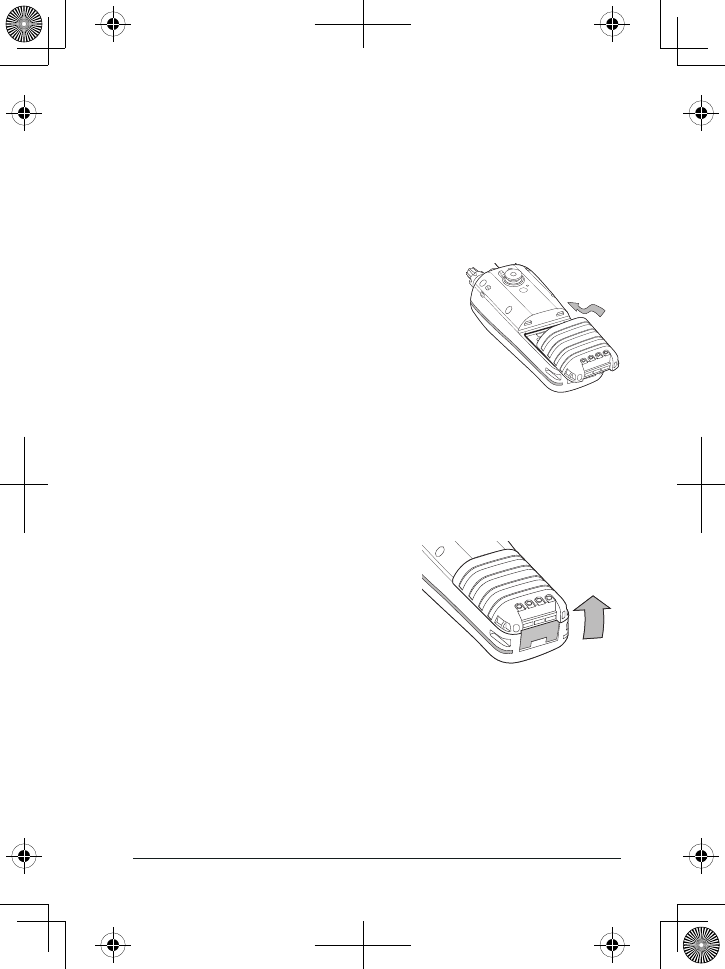
E-25
West Marine VHF255 Radio Owner’s Manual
Setting Up the Hardware
Installing the Battery
Your radio comes with a rechargeable Lithium Ion battery;
for shipping safety, the battery is not installed at the
factory. The empty alkaline battery case is installed as a
placeholder.
Insert the tabs on the battery
into the notches at the top of the
battery compartment.
Each time you remove the battery,
check the rubber seal around
the battery compartment. Make sure the seal is seated in
the groove and there is no dirt or debris on it. If the seal
looks worn or damaged, contact customer service to order
a replacement (SKU# 12012555; see back cover page for
contact information).
Lower the battery until it rests
at in the compartment.
Bring the battery latch up and
snap it into place.
Using the Alkaline Battery
Case
The radio also comes with a battery case that holds
four AAA-type alkaline batteries (not included). You can
use alkaline batteries as a backup for the Li-Ion battery
so you can still use your radio while your Li-Ion battery
is recharging. For best performance, West Marine
1)
2)
3)
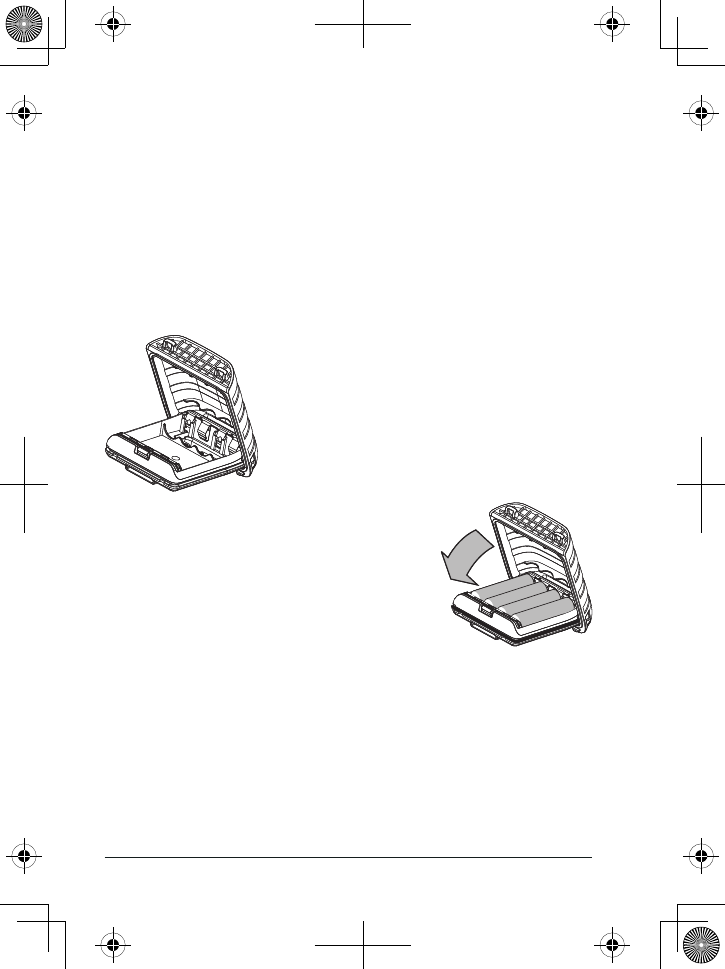
E-26 West Marine VHF255 Radio Owner’s Manual
recommends using extra-strength alkaline batteries such
as Duracell Ultra® batteries.
When using alkaline batteries, transmit power is limited to
a maximum of 2.5W.
Follow these steps to use the alkaline battery case:
Hold the lower part of the case in one hand with the
three battery contacts facing down. Use your thumb to
hold the notch on the lower part of the case.
With your other hand, grip the
upper part of the case and lift the
cover open.
Align the batteries’ positive
and negative terminals with the
drawing on the case and snap
each battery into place.
Insert the two hooks on the lower part
of the case into the notches on the
cover; close the cover. (The cover
ts snugly but you should not have
to force it closed.)
Each time you open the battery case,
check the rubber seal. Make sure the
seal is seated in the groove and there is no dirt or debris
on it. If the rubber seal looks worn or damaged, contact
customer service to order a replacement (SKU# 12303038;
see the back cover page for contact information).
Install the alkaline battery case in your radio just as
you do the Li-Ion battery (see page E-15).
1)
2)
3)
4)
5)
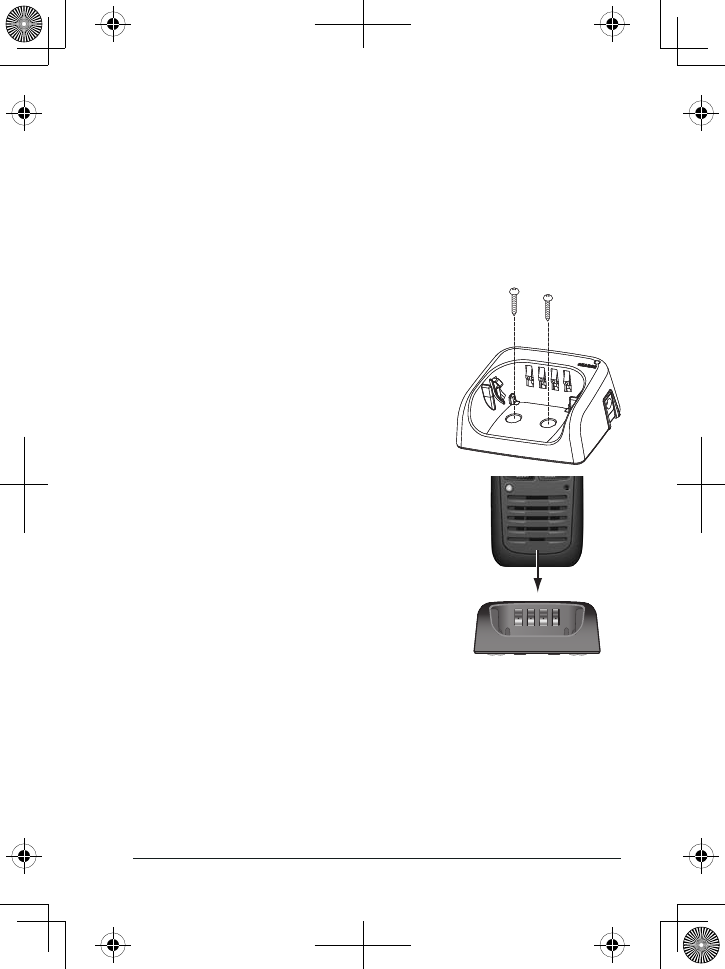
E-27
West Marine VHF255 Radio Owner’s Manual
WARNING! The case is designed to prevent the
accidental charging of alkaline batteries. Never
use alkaline batteries in the radio without the
case. Do not try to modify the battery case.
Mounting the Charger
You can mount the charger on any at surface.
Use the two holes at the base of
the charger as a template to mark
the drill holes.
Using a 1/8-inch (or 3 mm) drill
bit, drill two holes 1/2 inch (13mm)
deep.
Use the provided screws to attach
the charger to the surface.
Charging the Battery
Your radio includes a charger and a
rechargeable battery pack. Place your
radio in the charger with the display
facing forward. Make sure that the
CHARGE LED on the charger turns
orange.
Make sure to turn the radio OFF before placing it in the
charging cradle
Cautions:
Use only the battery and charger supplied with this radio.
Using a different charger or battery can damage the radio
and create a risk of re or shock.
1)
2)
3)
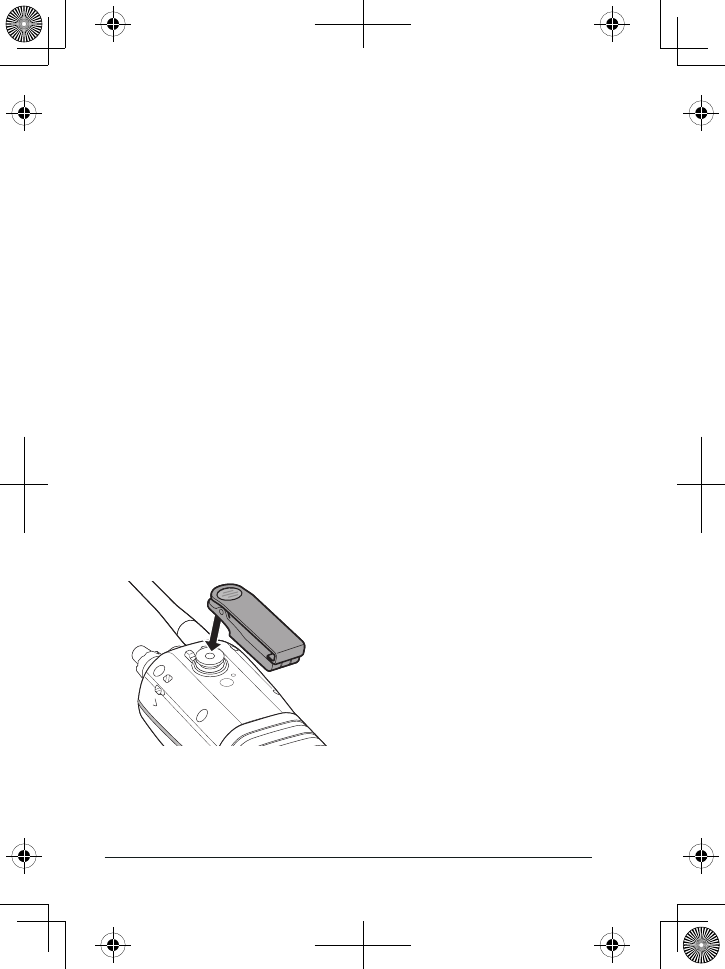
E-28 West Marine VHF255 Radio Owner’s Manual
The charger is not waterproof. If the charger falls into the
water, unplug it before attempting to remove it from the
water. After you remove the charger from the water, please
contact Customer Service (see the back cover page for
contact information).
Wipe off dirt or shake water from your radio before placing
in the charger if your radio gets dirty or wet.
Important notes on charging the battery
Charge the battery fully before using the radio. When
the battery is completely charged, the CHARGE LED
on the charger turns green.
Don’t use the charger when the ambient temperature is
below 0° C (32° F) or above 45° C (113° F).
If the radio is powered down, the battery can charge
in about seven hours. (If the radio is powered on, the
battery takes longer to charge.)
Attaching the Belt Clip
To attach the belt clip:
Rotate the belt clip so
that the nger indentation
is towards the top of the
radio.
Align the center of the clip
with the anchor post.
1)
2)
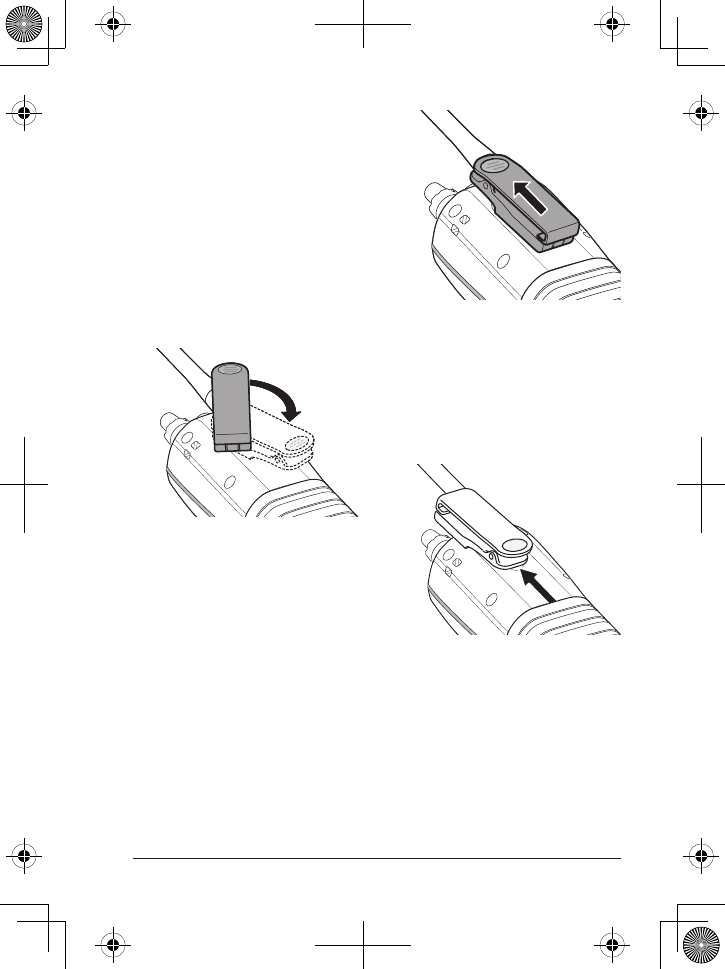
E-29
West Marine VHF255 Radio Owner’s Manual
Place the clip on the post and
slide the clip upwards until
it clicks into place.
To remove the belt clip:
Rotate the clip so that the
nger indentation is
towards the bottom of the
radio.
Slide the clip up until it
comes free of the anchor
post.
3)
1)
2)
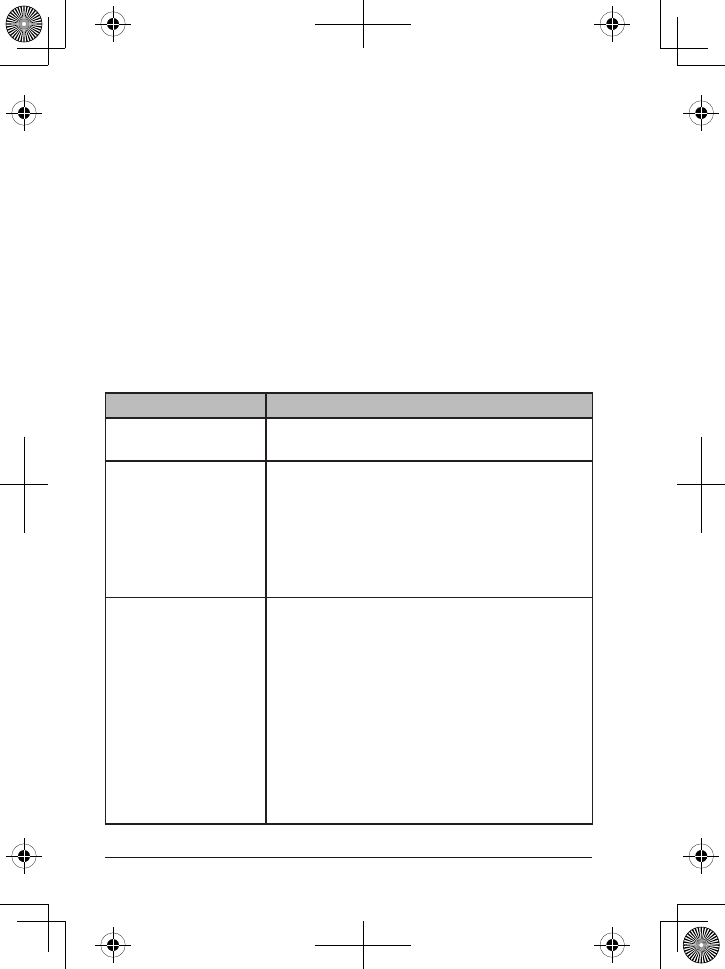
E-30 West Marine VHF255 Radio Owner’s Manual
Maintenance and Troubleshooting
Due to its rugged design, your radio requires very
little maintenance. However, it is a precision electronic
instrument, so you should follow a few precautions:
If the antenna has been damaged, do not transmit
except in an emergency situation. Transmitting with a
defective antenna may cause further radio damage.
You are responsible for continued FCC technical
compliance of your radio.
Common Questions
Problem Things to Try
The radio won’t turn
on. Charge the radio.
The power LED on
the charger doesn’t
turn on.
Don’t use the charger when the ambient
temperature is below 0° C (32° F) or above
45° C (113° F).
Make sure the charging contacts on the
radio and charger are clean.
Replace the battery.
–
–
–
The radio won’t
transmit.
Make sure you are not in weather or scan
mode.
Make sure you are not trying to transmit on a
receive-only channel or transmit at the wrong
power level for this channel (see the channel
lists starting on page E-34).
Check the battery power level; if it’s low, charge
the battery before trying to transmit.
Make sure the duration of each transmission is
less than 5 minutes.
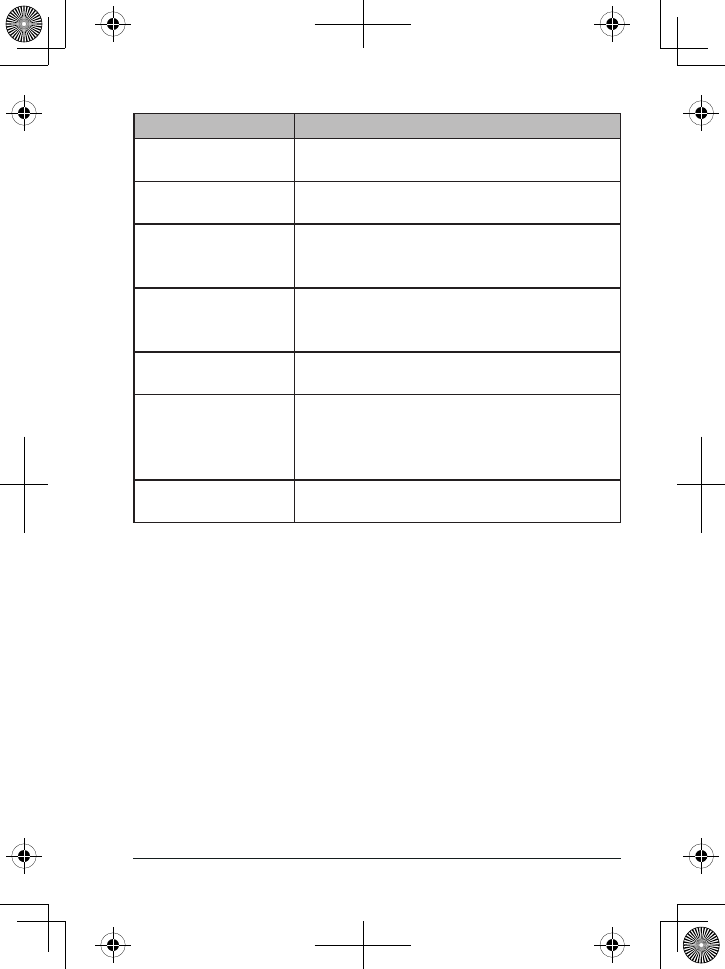
E-31
West Marine VHF255 Radio Owner’s Manual
Problem Things to Try
I can’t hear anything
from the speaker. Adjust the squelch level; it is probably too high.
The sound is mufed
or the volume is low. Clear water from the speaker grill.
Noise comes out of
the speaker all the
time Adjust the squelch level; it is probably too low.
I can transmit, but no
one can hear me.
Check your UIC channel settings: does
the area you are in use different channel
assignments?
I’m not getting hazard
alerts. Make sure Weather Alert Watch is turned on.
The display ashes,
and I don’t know why.
The channel number on the display will ash if
the radio is in a watch mode or in scan mode.
Try turning off scanning, Weather Alert Watch,
Triple Watch, or Dual Watch (see page E-10).
Where can I nd my
radio’s serial number? The serial number is on a plate inside the
battery compartment.
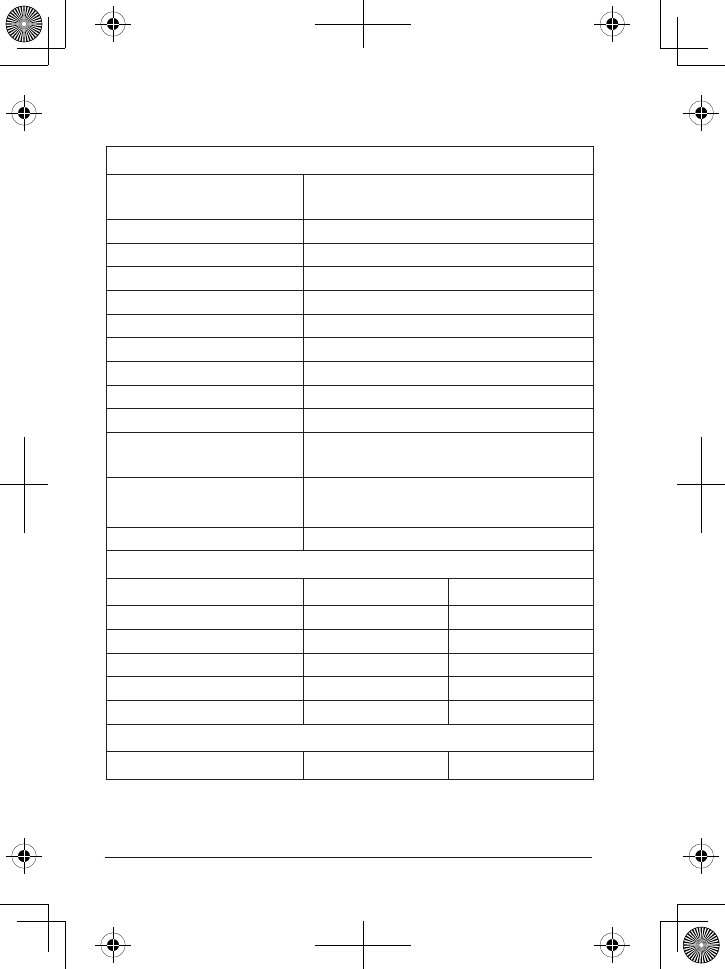
E-32 West Marine VHF255 Radio Owner’s Manual
Specications
General
Channels All US/International/Canada marine
channels, FRS/GMRS channels
10 Weather channels
Freq. Control PLL
Freq. Tol. Transmit: 1.5 PPM (at 25°C)
Receive: 1.5 PPM (at 25°C)
Oper. Temp. -4°F (-20°C) to +122°F(+50°C)
Antenna Flexible Whip
Microphone Built-in Electret type
Display Liquid Crystal Display
Speaker 8Ω 0.5 Watt
Power Source Rechargeable Lithium Ion Battery
7.4V 1040 mAh
Size (without antenna) 5.95 (H) x 2.56 (W) x 1.77 (D) inch
151 (H) x 65 (W) x 45 (D) mm
Weight 11.29 oz (320g) (w/battery and antenna)
Transmitter
Marine FRS/GMRS
Frequency Range 156~158 MHz 462~467 MHz
Frequency Stability ±10 PPM ±2.5 PPM
Power Output 5 W & 2.5W & 1W 0.4W
Spurious Emissions 70 dBm -30 dBm
Current Drain 1500 mA (5W) 700 mA
Receiver
Marine FRS/GMRS
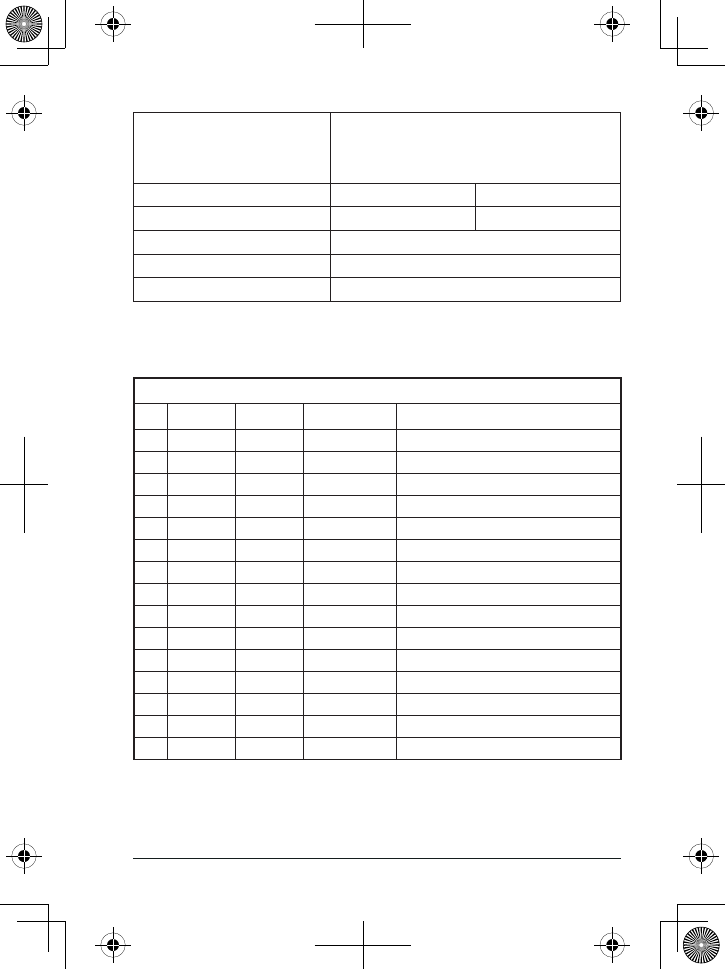
E-33
West Marine VHF255 Radio Owner’s Manual
Type
Double Conversion Super Heterodyne
Phase Locked Loop system for Local
Oscillator
Frequency Range 156~164 MHz 462~467 MHz
Sensitivity (12dB SINAD) 0.18 μV 0.25 μV
Audio Frequency Response +4.5 dB @ 500 Hz; -6 dB @ 2000Hz
Audio Output Power 0.35 W @10% THD
Current Drain Squelched: 70 mA; Max. Audio: 200 mA
Channels and Frequencies (MHz)
US channel frequencies and names
US Marine Channels
Ch RX Freq TX Freq Status Name
1A 156.050 156.050 Simplex Vessel trafc system/commercial
5A 156.250 156.250 Simplex Vessel trafc system/commercial
6 156.300 156.300 Simplex Inter-ship safety
7A 156.350 156.350 Simplex Commercial
8 156.400 156.400 Simplex Commercial
9 156.450 156.450 Simplex Non commercial
10 156.500 156.500 Simplex Commercial
11 156.550 156.550 Simplex Vessel trafc system
12 156.600 156.600 Simplex Vessel trafc system
13 156.650 156.650 Simplex, 1W Bridge to bridge
14 156.700 156.700 Simplex Vessel trafc system
15 156.750 Inhibit Receive only Environmental
16 156.800 156.800 Simplex Distress, safety, and calling
17 156.850 156.850 Simplex, 1W Govt maritime control
18A 156.900 156.900 Simplex Commercial
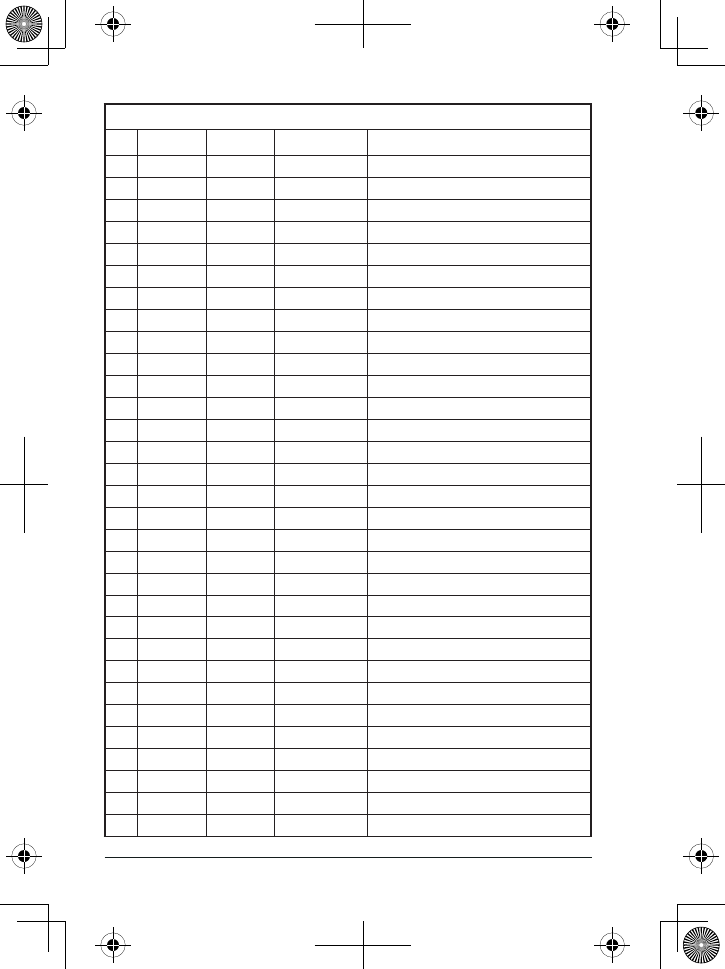
E-34 West Marine VHF255 Radio Owner’s Manual
US Marine Channels
Ch RX Freq TX Freq Status Name
19A 156.950 156.950 Simplex Commercial
20 161.600 157.000 Duplex Port operation
20A 157.000 157.000 Simplex Port operation
21A 157.050 157.050 Simplex Coast guard only
22A 157.100 157.100 Simplex Coast guard
23A 157.150 157.150 Simplex Coast guard only
24 161.800 157.200 Duplex Marine operator
25 161.850 157.250 Duplex Marine operator
26 161.900 157.300 Duplex Marine operator
27 161.950 157.350 Duplex Marine operator
28 162.000 157.400 Duplex Marine operator
63A 156.175 156.175 Simplex Vessel trafc system
65A 156.275 156.275 Simplex Port operation
66A 156.325 156.325 Simplex Port operation
67 156.375 156.375 Simplex, 1W Bridge To Bridge
68 156.425 156.425 Simplex Non Commercial
69 156.475 156.475 Simplex Non Commercial
70 156.525 Inhibit Receive only Digital Selective Calling
71 156.575 156.575 Simplex Non Commercial
72 156.625 156.625 Simplex Non Commercial (Ship-Ship)
73 156.675 156.675 Simplex Port Operation
74 156.725 156.725 Simplex Port Operation
75 156.775 156.775 Simplex, 1W Port Operation
76 156.825 156.825 Simplex, 1W Port Operation
77 156.875 156.875 Simplex, 1W Port Operation (Ship-Ship)
78A 156.925 156.925 Simplex Non Commercial
79A 156.975 156.975 Simplex Commercial
80A 157.025 157.025 Simplex Commercial
81A 157.075 157.075 Simplex Coast Guard
82A 157.125 157.125 Simplex Coast Guard
83A 157.175 157.175 Simplex Government
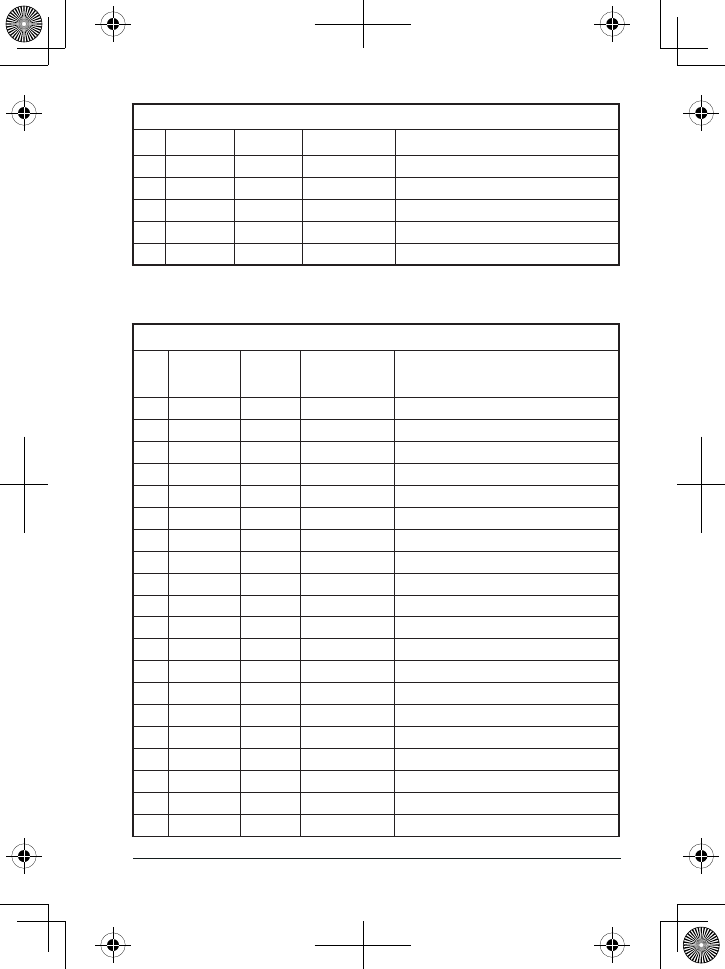
E-35
West Marine VHF255 Radio Owner’s Manual
US Marine Channels
Ch RX Freq TX Freq Status Name
84 161.825 157.225 Duplex Marine Operator
85 161.875 157.275 Duplex Marine Operator
86 161.925 157.325 Duplex Marine Operator
87 157.375 157.375 Simplex Marine Operator
88 157.425 157.425 Simplex Commercial (Ship-Ship)
Canadian channel frequencies and names
Canadian Marine Channels
Ch RX Freq TX
Freq Status Name
1 160.650 156.050 Duplex Marine Operator
2 160.700 156.100 Duplex Marine Operator
3 160.750 156.150 Duplex Marine Operator
4A 156.200 156.200 Simplex Canadian Coast Guard
5A 156.250 156.250 Simplex Vessel Trafc System
6 156.300 156.300 Simplex Inter-Ship Safety
7A 156.350 156.350 Simplex Commercial
8 156.400 156.400 Simplex Commercial
9 156.450 156.450 Simplex Boater Calling Channel
10 156.500 156.500 Simplex Commercial
11 156.550 156.550 Simplex Vessel Trafc System
12 156.600 156.600 Simplex Vessel Trafc System
13 156.650 156.650 Simplex, 1W Bridge To Bridge
14 156.700 156.700 Simplex Vessel Trafc System
15 156.750 156.750 Simplex, 1W Environmental
16 156.800 156.800 Simplex Distress, safety, calling
17 156.850 156.850 Simplex, 1W State Control
18A 156.900 156.900 Simplex Commercial
19A 156.950 156.950 Simplex Canadian Coast Guard
20 161.600 157.000 Duplex, 1W Port Operation
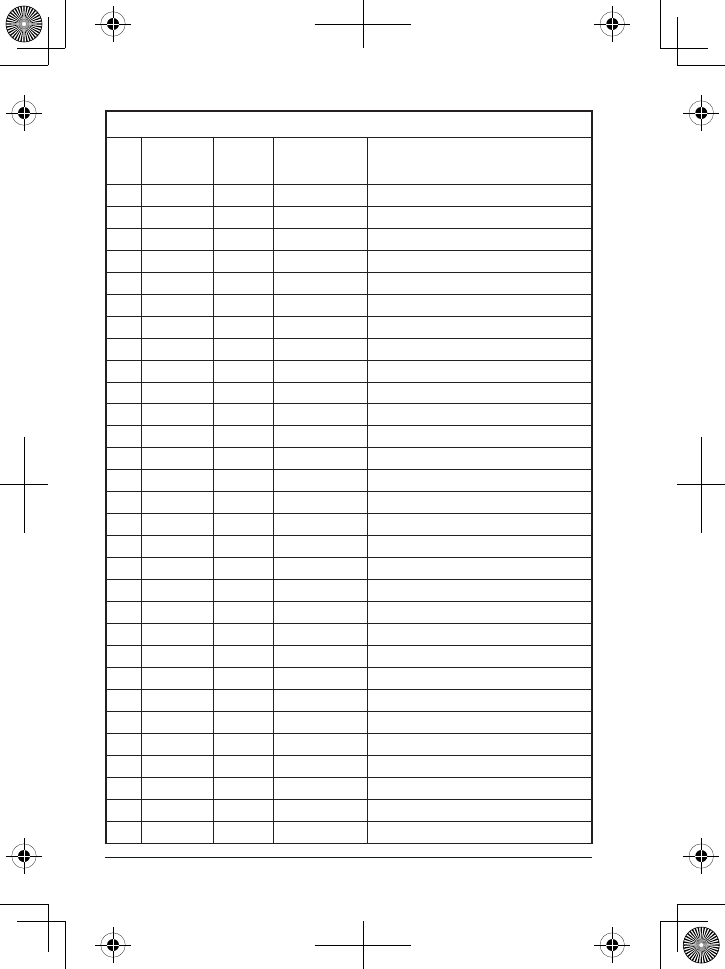
E-36 West Marine VHF255 Radio Owner’s Manual
Canadian Marine Channels
Ch RX Freq TX
Freq Status Name
21A 157.050 157.050 Simplex Canadian Coast Guard
22A 157.100 157.100 Simplex Canadian Coast Guard
23 161.750 157.150 Duplex Canadian Coast Guard
24 161.800 157.200 Duplex Marine Operator
25 161.850 157.250 Duplex Marine Operator
26 161.900 157.300 Duplex Marine Operator
27 161.950 157.350 Duplex Marine Operator
28 162.000 157.400 Duplex Marine Operator
60 160.625 156.025 Duplex Marine Operator
61A 156.075 156.075 Simplex Canadian Coast Guard
62A 156.125 156.125 Simplex Canadian Coast Guard
63A 156.175 156.175 Simplex Port Operation
64 160.825 156.225 Duplex Marine Operator
64A 156.225 156.225 Simplex Port Operation
65A 156.275 156.275 Simplex Port Operation
66A 156.325 156.325 Simplex, 1W Port Operation
67 156.375 156.375 Simplex Bridge To Bridge
68 156.425 156.425 Simplex Non Commercial
69 156.475 156.475 Simplex Non Commercial
70 156.525 Inhibit Receive only Digital Selective Calling
71 156.575 156.575 Simplex Non Commercial
72 156.625 156.625 Simplex Non Commercial
73 156.675 156.675 Simplex Port Operation
74 156.725 156.725 Simplex Port Operation
75 156.775 156.775 Simplex, 1W Port Operation
76 156.825 156.825 Simplex, 1W Port Operation
77 156.875 156.875 Simplex, 1W Port Operation
78A 156.925 156.925 Simplex Inter Ship
79A 156.975 156.975 Simplex Inter Ship
80A 157.025 157.025 Simplex Inter Ship
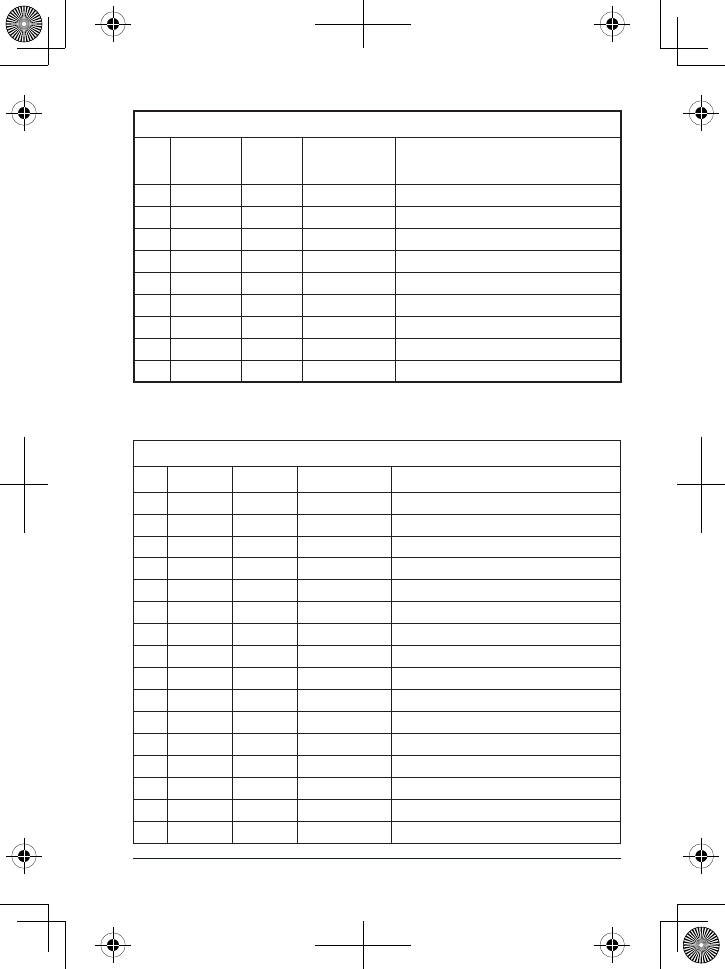
E-37
West Marine VHF255 Radio Owner’s Manual
Canadian Marine Channels
Ch RX Freq TX
Freq Status Name
81A 157.075 157.075 Simplex Canadian Coast Guard
82A 157.125 157.125 Simplex Canadian Coast Guard
83 161.775 157.175 Duplex Canadian Coast Guard
83A 157.175 157.175 Simplex Canadian Coast Guard
84 161.825 157.225 Duplex Marine Operator
85 161.875 157.275 Duplex Marine Operator
86 161.925 157.325 Duplex Marine Operator
87 157.375 157.375 Simplex Port Operation
88 157.425 157.425 Simplex Port Operation
International channel frequencies and names
International Marine Channels
Ch RX Freq TX Freq Status Name
1 160.650 156.050 Duplex Marine operator
2 160.700 156.100 Duplex Marine operator
3 160.750 156.150 Duplex Marine operator
4 160.800 156.200 Duplex Marine operator
5 160.850 156.250 Duplex Marine operator
6 156.300 156.300 Simplex Inter-ship safety
7 160.950 156.350 Duplex Marine operator
8 156.400 156.400 Simplex Commercial (ship-ship)
9 156.450 156.450 Simplex Boater calling channel
10 156.500 156.500 Simplex Commercial
11 156.550 156.550 Simplex Vessel trafc system
12 156.600 156.600 Simplex Vessel trafc system
13 156.650 156.650 Simplex Bridge to bridge
14 156.700 156.700 Simplex Vessel trafc system
15 156.750 156.750 Simplex, 1W Environmental
16 156.800 156.800 Simplex Distress, safety, calling
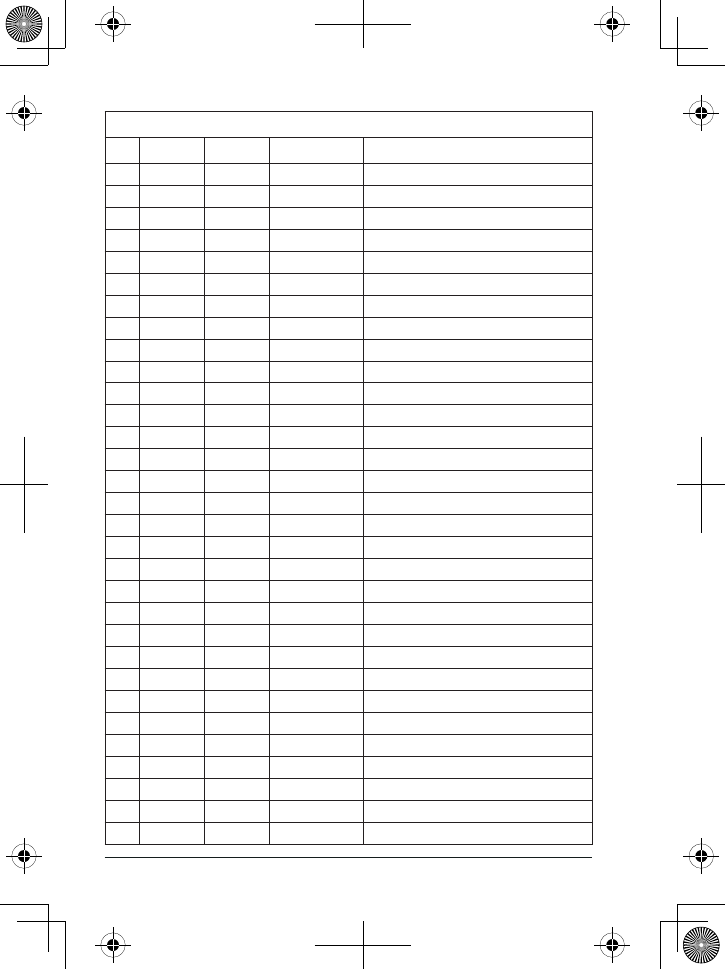
E-38 West Marine VHF255 Radio Owner’s Manual
International Marine Channels
Ch RX Freq TX Freq Status Name
17 156.850 156.850 Simplex, 1W Govt maritime control
18 161.500 156.900 Duplex Port operation
19 161.550 156.950 Duplex Commercial
20 161.600 157.000 Duplex Port operation
21 161.650 157.050 Duplex Port operation
22 161.700 157.100 Duplex Port operation
23 161.750 157.150 Duplex Marine operator
24 161.800 157.200 Duplex Marine operator
25 161.850 157.250 Duplex Marine operator
26 161.900 157.300 Duplex Marine operator
27 161.950 157.350 Duplex Marine operator
28 162.000 157.400 Duplex Marine operator
60 160.625 156.025 Duplex Marine operator
61 160.675 156.075 Duplex Marine operator
62 160.725 156.125 Duplex Marine operator
63 160.775 156.175 Duplex Marine operator
64 160.825 156.225 Duplex Marine operator
65 160.875 156.275 Duplex Marine operator
66 160.925 156.325 Duplex Marine operator
67 156.375 156.375 Simplex Bridge to bridge
68 156.425 156.425 Simplex Non commercial
69 156.475 156.475 Simplex Non commercial
70 156.525 Inhibit Receive only Digital Selective Calling
71 156.575 156.575 Simplex Non commercial
72 156.625 156.625 Simplex Non commercial
73 156.675 156.675 Simplex Port operation
74 156.725 156.725 Simplex Port operation
75 156.775 156.775 Simplex, 1W Port operation
76 156.825 156.825 Simplex, 1W Port operation
77 156.875 156.875 Simplex Port operation (ship-ship)
78 161.525 156.925 Duplex Port operation
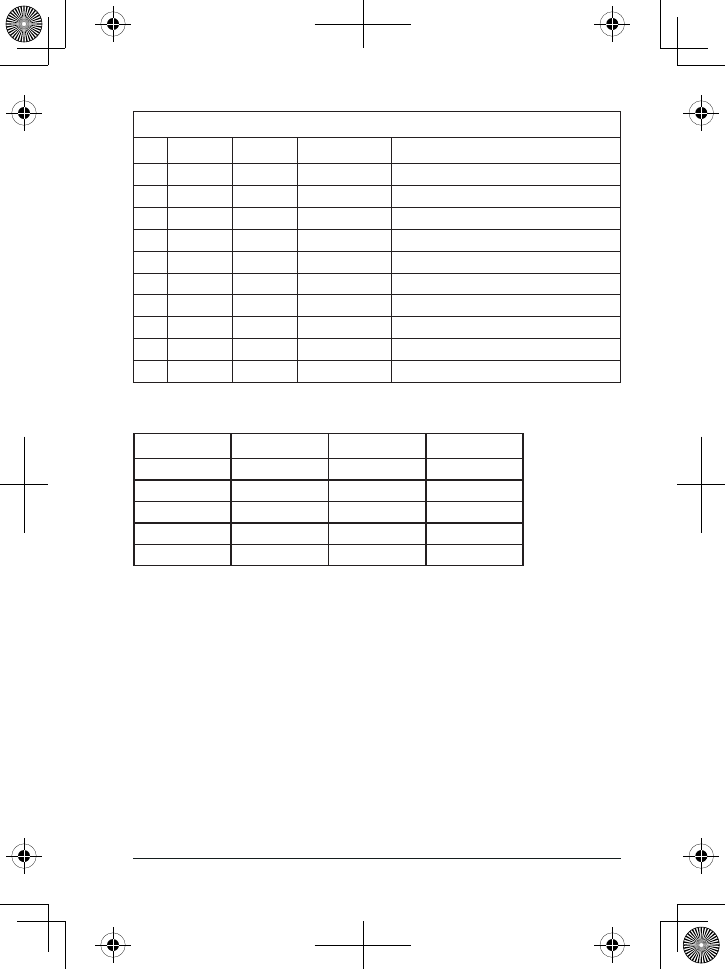
E-39
West Marine VHF255 Radio Owner’s Manual
International Marine Channels
Ch RX Freq TX Freq Status Name
79 161.575 156.975 Duplex Port operation
80 161.625 157.025 Duplex Port operation
81 161.675 157.075 Duplex Port operation
82 161.725 157.125 Duplex Port operation
83 161.775 157.175 Duplex Port operation
84 161.825 157.225 Duplex Marine operator
85 161.875 157.275 Duplex Marine operator
86 161.925 157.325 Duplex Marine operator
87 157.375 157.375 Simplex Marine operator
88 157.425 157.425 Simplex Marine operator
Weather channel frequencies and names
Channel RX Channel RX
WX01 162.5500 WX06 162.5000
WX02 162.4000 WX07 162.5250
WX03 162.4750 WX08 161.6500
WX04 162.4250 WX09 161.7750
WX05 162.4500 WX10 163.2750
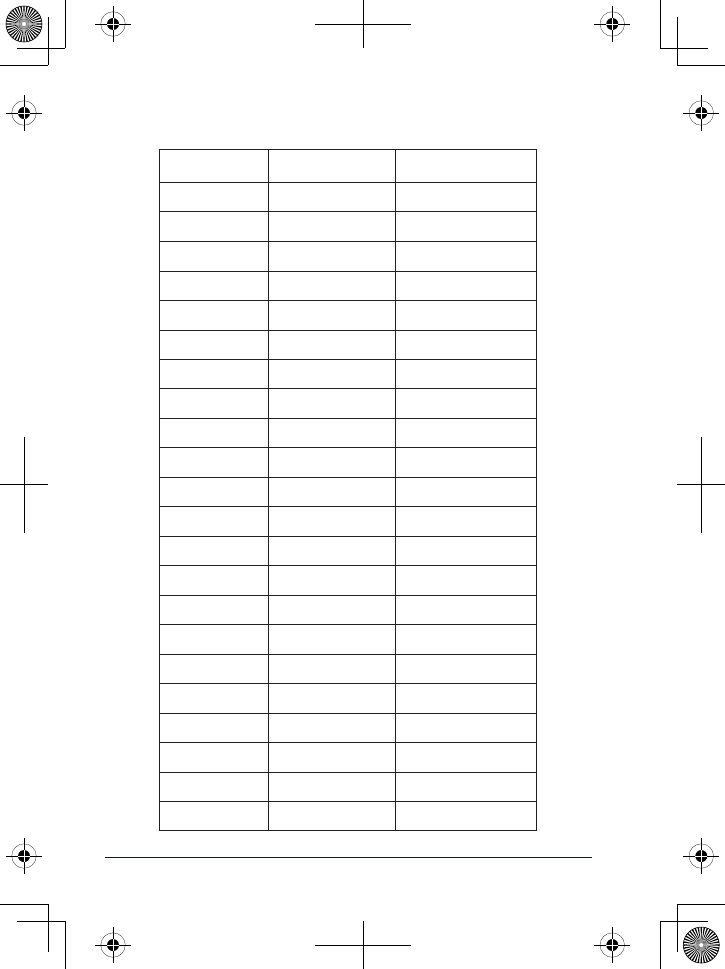
E-40 West Marine VHF255 Radio Owner’s Manual
FRS/GMRS Channels
CH No. RX Freq. (MHz) TX Freq.(MHz)
1 462.5625 462.5625
2 462.5875 462.5875
3 462.6125 462.6125
4 462.6375 462.6375
5 462.6625 462.6625
6 462.6875 462.6875
7 462.7125 462.7125
8 467.5625 467.5625
9 467.5875 467.5875
10 467.6125 467.6125
11 467.6375 467.6375
12 467.6625 467.6625
13 467.6875 467.6875
14 467.7125 467.7125
15 462.5500 462.5500
16 462.5750 462.5750
17 462.6000 462.6000
18 462.6250 462.6250
19 462.6500 462.6500
20 462.6750 462.6750
21 462.7000 462.7000
22 462.7250 462.7250
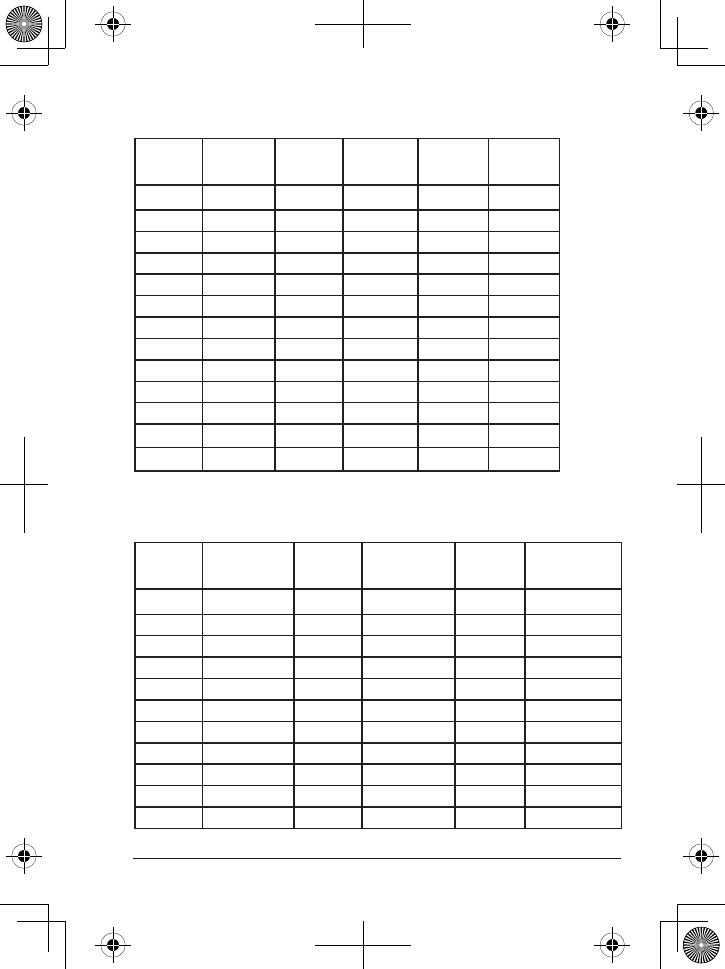
E-41
West Marine VHF255 Radio Owner’s Manual
CTCSS Code List
Code
No. Freq.
(Hz) Code
No. Freq.
(Hz) Code
No. Freq.
(Hz)
OFF Off 13 103.5 26 162.2
1 67.0 14 107.2 27 167.9
2 71.9 15 110.9 28 173.8
3 74.4 16 114.8 29 179.9
4 77.0 17 118.8 30 186.2
5 79.7 18 123.0 31 192.8
6 82.5 19 127.3 32 203.5
7 85.4 20 131.8 33 210.7
8 88.5 21 136.5 34 218.1
9 91.5 22 141.3 35 225.7
10 94.8 23 146.2 36 233.6
11 97.4 24 151.4 37 241.8
12 100.0 25 156.7 38 250.3
DCS Code List
Code
No. DCS Code
(Octal) Code
No. DCS Code
(Octal) Code
No. DCS Code
(Octal)
39 023 50 072 61 152
40 02 51 073 62 155
41 026 52 074 63 156
42 031 53 114 64 162
43 032 54 115 65 165
44 043 55 116 66 172
45 047 56 125 67 174
46 051 57 131 68 205
47 054 58 132 69 223
48 065 59 134 70 226
49 071 60 143 71 243
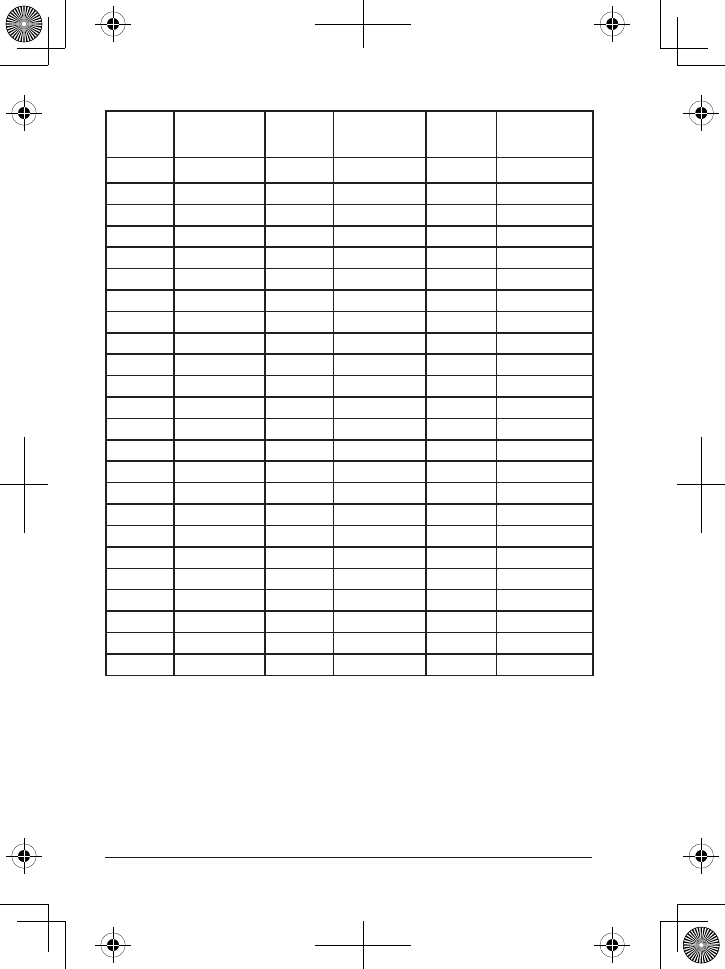
E-42 West Marine VHF255 Radio Owner’s Manual
Code
No. DCS Code
(Octal) Code
No. DCS Code
(Octal) Code
No. DCS Code
(Octal)
72 244 96 464 120 743
73 245 97 465 121 754
74 251 98 466 122 36
75 261 99 503 123 53
76 263 100 506 124 122
77 265 101 516 125 145
78 271 102 632 126 212
79 306 103 546 127 225
80 311 104 565 128 246
81 315 105 606 129 252
82 331 106 612 130 255
83 343 107 624 131 266
84 346 108 627 132 274
85 351 109 631 133 325
86 364 110 632 134 332
87 365 111 654 135 356
88 371 112 662 136 446
89 411 113 664 137 452
90 412 114 703 138 454
91 413 115 712 139 455
92 423 116 723 140 462
93 431 117 731 141 523
94 432 118 732 142 526
95 445 119 734

E-43
West Marine VHF255 Radio Owner’s Manual
Regulations and Safety Warnings
Maritime Radio Services Operation
Warning! This transmitter will operate on channels/frequencies that have
restricted use in the United States. The channel assignments include
frequencies assigned for exclusive use of the U.S. Coast Guard, use in
Canada, and use in international waters. Operation on these frequencies
without proper authorization is strictly forbidden. See pages E-34 through
E-31 for tables of the available channels and their uses. If you are still
not certain which channels to use, see the FCC maritime radio page at
the FCC website (
http://wireless.fcc.gov/marine/
) or contact the FCC
Call Center at 1-888-CALL-FCC. For individuals requiring a license, such
as commercial users, you should obtain a license application from your
nearest FCC eld ofce (for US users) or Industry Canada (for Canadian
users).
Basic Radio Guidelines
You should familiarize yourself with the rules on marine radios and be
aware of which rules apply to your boat. Complete guidelines for all ship
and marine radio types can be found at the US Coast Guard website
under the topic Radio Info for Boaters (the direct link is
http://www.navcen.uscg.gov/marcomms/boater.htm
). Here are a few
guidelines that affect nearly all boaters.
If you have a VHF radio on your boat, you must maintain a watch on
channel 16 (156.800 MHz) whenever the radio is not being used to
communicate. Starting in 2004, if a radio is carried, it must be on and
set to channel 16 whenever your boat is underway.
If you hear a distress call, wait a few minutes to let a shore station or
Coast Guard vessel respond. If no other station has responded after 5
minutes, you must respond to the distress call.
•
•
WARNING! Read this information
before using the radio.
WARNING! Read this information
before using the radio.

E-44 West Marine VHF255 Radio Owner’s Manual
Do not make false mayday or distress calls as a prank or to test your
radio. (This is essentially like making a false 9-1-1 call; you may be
subject to nes.)
FCC/Industry Canada Information
Certication: FCC Part 80 or RSS-182
Output Power: 5W
Emission: 16K0F3E
Transmitter Frequency Range: 156.025-157.425 MHz
This device complies with Part 15 of the FCC Rules. Operation is subject
to the following two conditions: (1) This device may not cause harmful
interference. (2) This device must accept any interference received,
including interference that may cause undesired operation.
Unauthorized changes or modications to this equipment may void
compliance with the FCC Rules. Any change or modication must be
approved in writing by West Marine. Changes or modications not
approved by West Marine could void the user’s authority to operate the
equipment.
FCC RF Exposure Information
In August 1996 the Federal Communications Commission (FCC) of the
United States with its action in Report and Order FCC 96-326 adopted
an updated safety standard for human exposure to radio frequency
electromagnetic energy emitted by FCC regulated transmitters. Those
guidelines are consistent with the safety standard previously set by both
U.S. and international standards bodies. The design of the radio complies
with the FCC guidelines and these international standards.
Never allow children to operate the radio without adult supervision and the
knowledge of the following guidelines.
WARNING! It is up to the user to properly operate this radio transmitter to
insure safe operation. Please adhere to the following:
Use only the supplied or an approved antenna. Unauthorized
antennas, modications, or attachments could impair call quality,
damage the radio, or violate FCC regulations.
•
•

E-45
West Marine VHF255 Radio Owner’s Manual
Do not use the radio with a damaged antenna. If a damaged antenna
comes into contact with the skin, a minor burn may result. Please
contact your local dealer for a replacement antenna.
Hand-held Operation (Held-to-Face)
This device was evaluated for typical hand-held (held-to-face) operations
with a 1 inch spacing from the front of the radio. For hand-held operation,
the radio should be held 1 inch from the user’s face in order to comply with
FCC RF exposure requirements.
Body-Worn Operation
This device was tested for typical body-worn operations using the supplied
belt-clip. To maintain compliance with FCC RF exposure requirements,
body-worn operations are restricted to the supplied belt-clip. For hand-
held operation, the radio should be held 1 inch from the user’s face.
The use of accessories that do not satisfy these requirements may not
comply with FCC RF exposure requirements and should be avoided. For
more information about RF exposure, please visit the FCC website at
www.fcc.gov
.
Lithium ion battery warning
This equipment contains a rechargeable Lithium Ion battery. The
rechargeable battery contained in this equipment may explode if
disposed of in a re.
Do not short-circuit the battery.
Do not charge the rechargeable battery used in this equipment in any
charger other than the one specied in the owner’s manual. Using
another charger may damage the battery or cause it to explode.
Li-Ion batteries must be recycled or disposed of properly.
Avoid exposing the battery (whether attached to the radio or not) to
direct sunlight, heated cars, or temperatures below -4°F (-20°C) or
above +140°F (+60°C). Exposing the chemical contained within the
battery pack to temperatures above +140°F (+60°C) may cause the
battery to rupture, fail, or reduce performance.
•
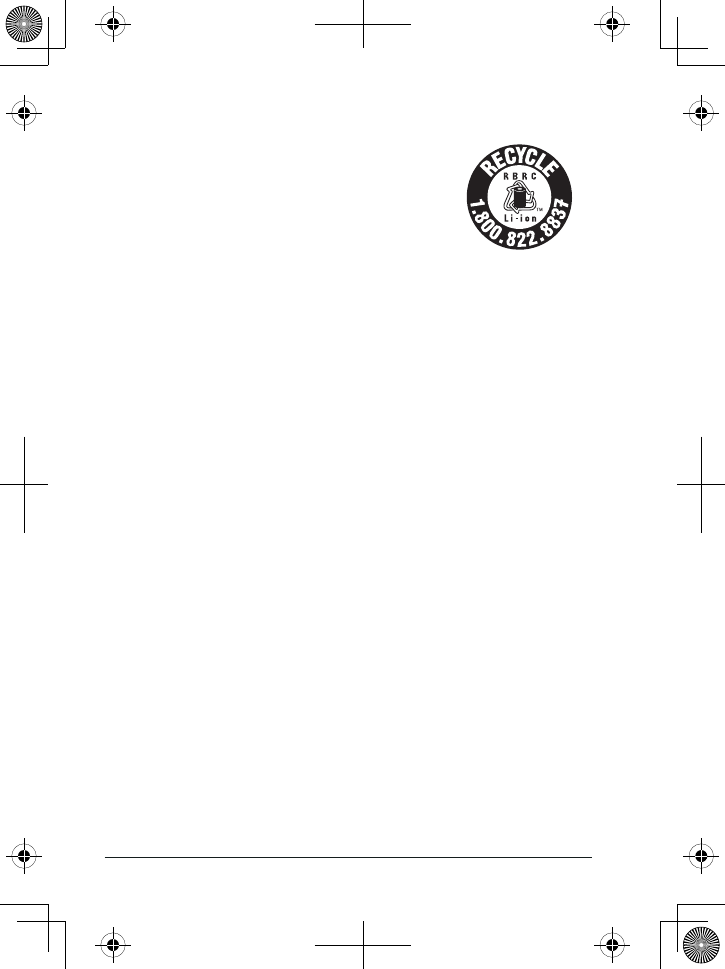
E-46 West Marine VHF255 Radio Owner’s Manual
In case of exposure to the cell contents, wash the
affected area thoroughly, and seek medical
attention.
As part of our commitment to protecting our
environment and conserving natural resources,
West Marine voluntarily participates in an RBRC®
industry program to collect and recycle used Li-Ion
batteries within the United States. Please call 1-
800-8-BATTERY for information on Li-Ion battery recycling in your area.
(RBRC® is a registered trademark of the Rechargeable Battery
Recycling Corporation.)
Three Year Limited Warranty Statement
This Limited Warranty is Void outside the United States of America
and Canada.
What Does This Limited Warranty Cover?
West Marine warrants to the original retail purchaser of the West Marine
product, where the purchase is made in the United States or Canada, that
for thirty-six (36) months from date of original retail purchase said product
will be free from defects in materials and craftsmanship with only the
limitations or exclusions set out below.
How Long Does This Limited Warranty Last?
This limited warranty is valid for thirty-six (36) months from the date of the
original retail purchase from West Marine within the United States (the
“Limited Warranty Term”).
The warranty period is not extended if we repair or replace a warranted
product or any parts. West Marine reserves the right to change the
availability of limited warranties, at its discretion, but any changes will not
be retroactive and will only apply to subsequent purchases.
What Does This Limited Warranty Not Cover?
This limited warranty is invalid where and does not cover:

E-47
West Marine VHF255 Radio Owner’s Manual
Software.
Commercial or industrial use or operation.
Normal maintenance items or normal wear and tear.
Problems resulting from re or exposure to caustic liquids.
The product was damaged, modied or altered.
The product was used as part of any conversion kits, subassemblies,
or any congurations not appropriate or contemplated for this product
or its use.
Damage or loss occurring during return shipment of the product to West
Marine or its authorized service representative.
The product was subject to improper service, repair, installation,
storage, maintenance, alteration or application.
Problems that result from accident, neglect, abuse, misuse or issues
with electrical power,
Problems caused by accessories, parts or components added to the
product that are not appropriate for this product or its use.
THIS WARRANTY GIVES YOU SPECIFIC LEGAL RIGHTS, AND
YOU MAY ALSO HAVE OTHER RIGHTS WHICH VARY FROM
STATE TO STATE (OR JURISDICTION TO JURISDICTION). WEST
MARINE’S RESPONSIBILITY FOR MALFUNCTIONS AND DEFECTS
IN HARDWARE IS LIMITED TO REPAIR OR REPLACEMENT AS
SET FORTH IN THIS WARRANTY STATEMENT. ALL EXPRESS AND
IMPLIED WARRANTIES FOR THE PRODUCT, INCLUDING BUT NOT
LIMITED TO ANY IMPLIED WARRANTIES AND CONDITIONS OF
MERCHANTABILITY AND FITNESS FOR A PARTICULAR PURPOSE,
ARE LIMITED IN TIME TO THE TERM OF THIS LIMITED WARRANTY
(AS SPECIFIED ABOVE). NO WARRANTIES, WHETHER EXPRESS
OR IMPLIED, WILL APPLY AFTER THE LIMITED WARRANTY
PERIOD HAS EXPIRED. SOME STATES DO NOT ALLOW
LIMITATIONS ON HOW LONG AN IMPLIED WARRANTY LASTS, SO
THE ABOVE LIMITATIONS MAY NOT APPLY TO YOU.
WE DO NOT ACCEPT LIABILITY BEYOND THE REMEDIES
PROVIDED FOR IN THIS LIMITED WARRANTY OR FOR

E-48 West Marine VHF255 Radio Owner’s Manual
CONSEQUENTIAL OR INCIDENTAL DAMAGES, INCLUDING,
WITHOUT LIMITATION, ANY LIABILITY FOR THIRD-PARTY CLAIMS
AGAINST YOU FOR DAMAGES, FOR PRODUCTS NOT BEING
AVAILABLE FOR USE, OR FOR LOST DATA OR LOST SOFTWARE.
OUR LIABILITY WILL BE NO MORE THAN THE AMOUNT YOU PAID
FOR THE PRODUCT THAT IS THE SUBJECT OF A CLAIM. THIS IS
THE MAXIMUM AMOUNT FOR WHICH WE ARE RESPONSIBLE.
SOME STATES DO NOT ALLOW THE EXCLUSION OR LIMITATION
OF INCIDENTAL OR CONSEQUENTIAL DAMAGES, SO THE ABOVE
LIMITATION OR EXCLUSION MAY NOT APPLY TO YOU.
What Must I Do To Keep the Warranty in Effect?
You must keep your receipt or other appropriate documentation as proof
of the date of sale and purchase.
You must keep your serial number or order number for the product.
This is found on the product itself or on your receipt.
You must not do any of the things that will make the warranty invalid as
provided for in this warranty statement.
You must use, install, maintain and operate the product in accordance
with published specications and the user’s manual.
What Do I Do If I Need Warranty Service?
Before the warranty expires, please call us at 1-800-BOATING (1-800-
262-8464). Please also have your West Marine serial number or order
number available.
When you contact us, we will issue a Return Material Authorization
Number for you to include with your return. We will also provide you the
address of where to ship the product.
You must return the product to us in its original or equivalent packaging,
prepay shipping charges, and insure the shipment or accept the risk if
the product is lost or damaged in shipment.

E-49
West Marine VHF255 Radio Owner’s Manual
What Will West Marine Do?
During the Limited Warranty Term, if the product you return to us proves
to be defective in materials or workmanship and not for the reasons which
would otherwise disqualify it (as explained here), then we will:
At West Marine’s option, we will repair the product or, if we are unable
to repair it, we will replace it with a comparable product that is new or
refurbished;
Or, as an alternative, at West Marine’s option, we will refund you the
original purchase price;
If we repair or replace the product, we will return the repaired or
replacement product to you; and
Pay to ship the repaired or replacement product to you if you use
an address in the United States (excluding Puerto Rico and U.S.
possessions and territories). Otherwise, we will ship the product to you
freight collect.
If we determine that the problem is not covered under this warranty,
we will notify you of this when we return your product to you to the
address you provide us in the United States (excluding Puerto Rico
and U.S. possessions and territories).
We use new and refurbished parts made by various manufacturers
in performing warranty repairs and in building replacement parts
and systems. Refurbished parts and systems are parts or systems
that have been returned to West Marine, some of which were
never used by a customer. Replacement parts and systems are
covered for the remaining time left in the Limited Warranty Term
for the product you bought (whatever time remains in the twelve
months since purchase). West Marine owns all parts removed from
repaired products.
Maintenance is the Owner’s Responsibility
Cleaning, polishing, lubricating, replacing lters, tuning, replacing worn
parts, using your purchased product according to the user’s manual, and
regularly maintaining your purchased product is your responsibility.

E-50 West Marine VHF255 Radio Owner’s Manual
What if I purchased a Plus Protection Plan?
Service will be provided to you under the terms of the Plus Protection Plan
Contract. Please refer to that contract for details on how to obtain service.
How State Law Relates to the Warranty.
This warranty gives you specic legal rights, and you may also have other
rights which vary from state to state.